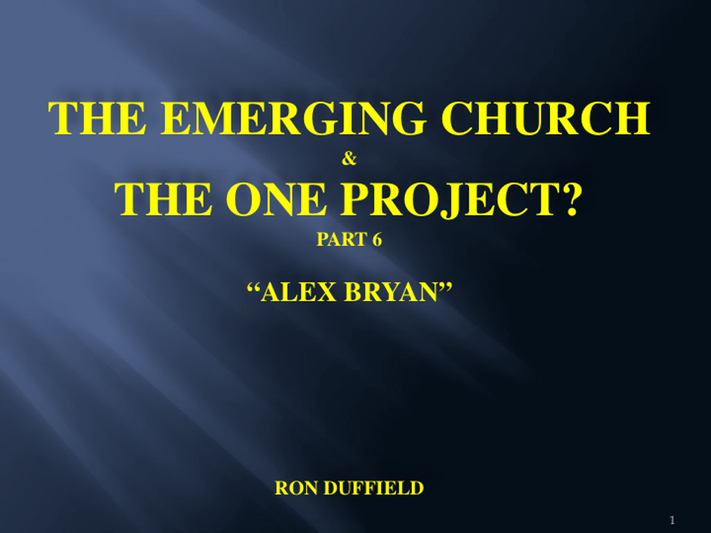
My study into the emerging church started when a pastor back East asked if I knew anything about “The One Project”. When I began to study into the history of the Project and those who started the movement, I was lead to enquire about the Emerging Church and its teachings and history. I found that it deals with much more than just “spiritual formation” and “centering prayer.”
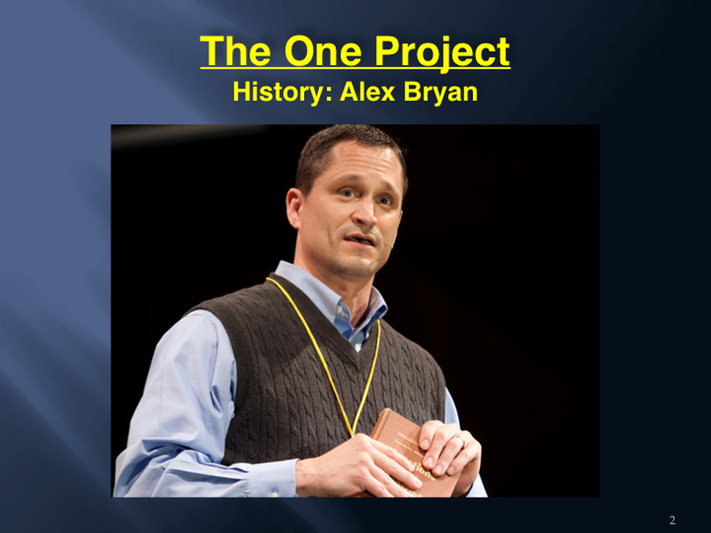
De Oliveira states that he and 4 others gathered in Denver and came up with the One Project. “In July 2010, five simple Jesus followers (Alex Bryan, Japhet De Oliveira, Sam Leonor, Tim Gillespie and Terry Swenson) got together in room 602 at the Holiday Inn in Denver. …” (Japhet De Oliveira, “The One Project: Our Purpose and Mission,” http://the1project.org/assets/documents/the-one-project.pdf). We will now take a look at Alex Bryan history and ministry in the Adventist Church.
At the same time we must be clear that we not judging the motives or sincere intent of those who sense a need for change in our church, a remedy for the Laodicean condition, but only question if the agenda of the Projects leaders as seen in their history is what our church needs.
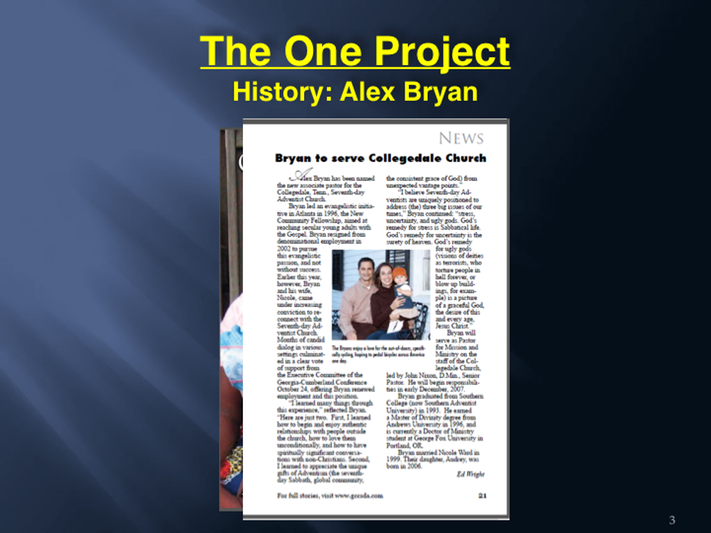
In the Nov. 5, 2007 article in the Communique, a magazine published by the Georgia Cumberland Conference, Alex Bryan's history is briefly covered. Beautiful young family. But with all do respect, what has been Bryan’s history?
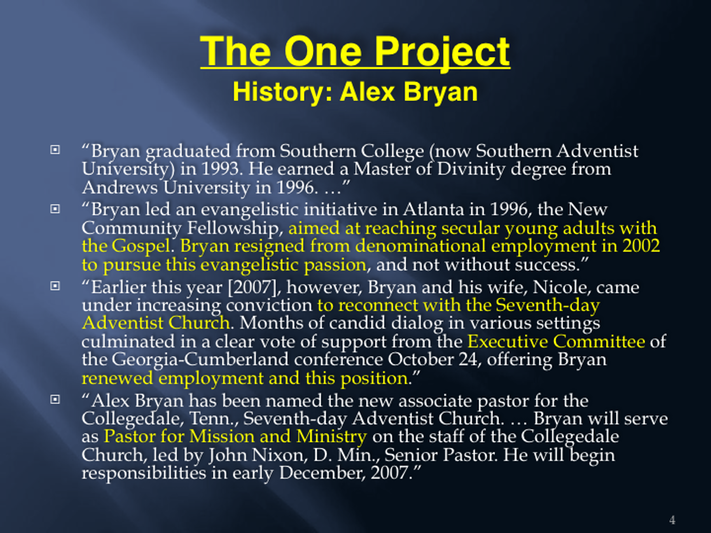
In the Nov. 5, 2007 article in the Communique, a magazine published by the Georgia Cumberland Conference, Alex Bryan's history is briefly covered.
The article indicates that Bryan put his vision to practical use in a church plant but after nearly 6 years left SDA employment. On his return it would appear, however, that he had left more than SDA employment if he had a “conviction to reconnect with the Seventh-day Adventist Church.” The article fails to explain why this was the case. As with many other articles in Adventist magazines, this seems to be written “politically correct” so as to avoid controversy.
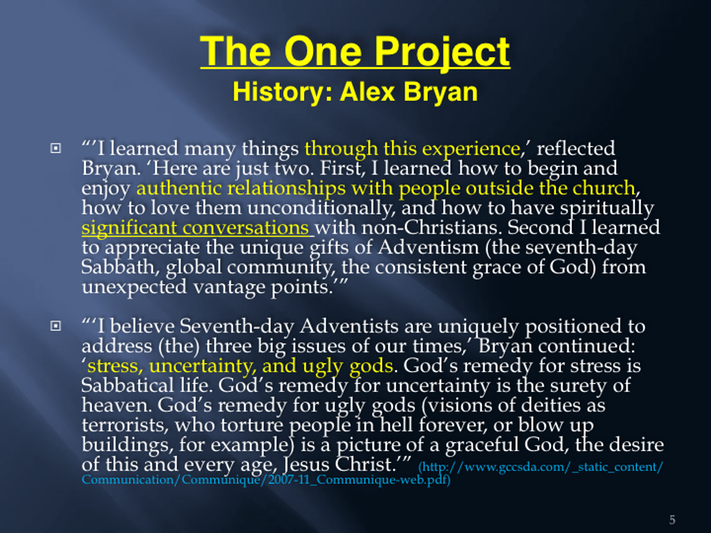
In the Nov. 5, 2007 article in the Communique, a magazine published by the Georgia Cumberland Conference, Alex Bryan's history is briefly covered. Here is his own words Bryan give a short well worded history. What “experience” is Bryan talking about? Bryan’s “significant conversations” seemed to lead his church plant away from the denomination? (Yet the same lingo is used for The One Project; see presentation 10).The article doesn’t indicate that Bryan made any mistakes or that he is expressing valuable lessons learned from such mistakes. If his experience was the result of his vision of church planting which he obtained from Willow Creek (see below), then this philosophy lead him “to resign from denominational employment” with his church plant. Has his vision changed any since then? Is the One Project just another of his visions based on the same philosophy, which he has embraced without any admittance that mistakes were made in his church plant in Atlanta? Is it just a witch hunt to ask such questions?
Adventist Today, ran an article soon after Alex’s return to Southern: “Following the decision of the Conference Executive Committee to employ Bryan, the Church Board voted by a 16-14 margin to affirm the decision. ‘I understand the nervousness some felt,’ said Bryan. ‘I hope to rebuild these relationships in the days to come.’ During the deliberations, said Senior Pastor John Nixon, the biblical story of John Mark was considered. As told in Acts 15, John Mark had at one point separated from Paul and Barnabas. Later, however, John Mark rejoined the ministry.” (“Atlanta Pastor Reconciles With Georgia-Cumberland Conference,” Adventist Today, Jan. Feb., 2008, p. 8) [See slide below]
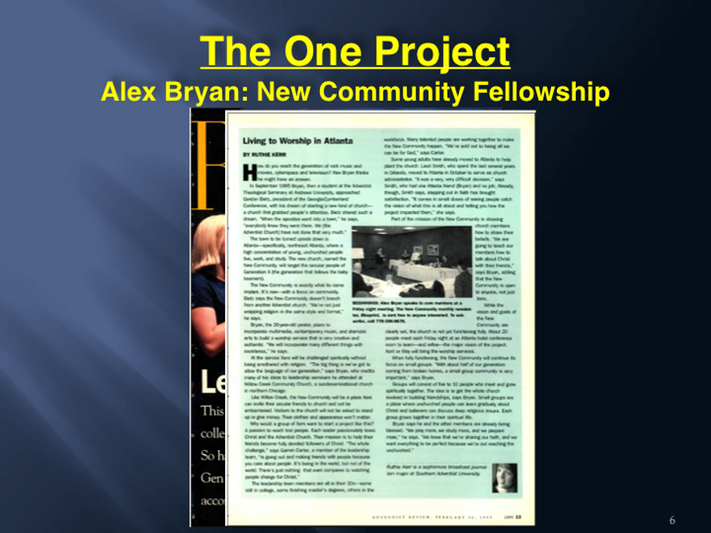
But what really was Alex Bryan’s experience with his church plant of which he speaks of in the above article in 2007? We must go back to the beginning to get the answers.
Many 1990s Review articles continually pushed the “New” worship services popping up on SDA University Campuses and in new church plants. In this same Feb. 20, 1997 Review an article was written about Alex Bryan’s new church plant, “The New Community”.
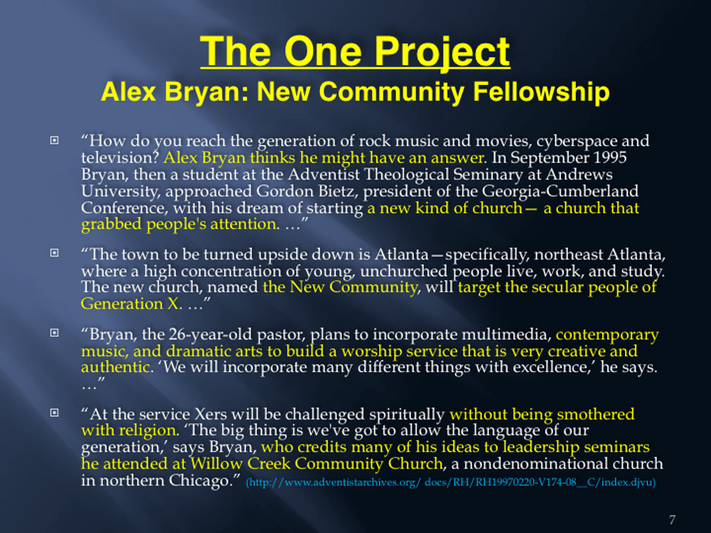
1990s Review articles continually pushed the “New” worship services popping up on SDA University Campuses. In this 1997 Review an article was written about Alex Bryan’s new church plant, “The New Community”. The sad thing is that Bryan and all the other leaders of The One Project, first learned their mission ideas while attending Adventist Seminary. It would seem that if their ideas are faulty then there is plenty of blame to go around. While at Andrews Bryan attended Willow Creek Community Church seminars where he got his ideas.
Why is it that when the church starts on these questionable adventures and pours thousands of dollars into them, information is readily published in the church papers, but when they fail outright, very little if anything is said? Why does it seem that when anyone questions the current vision of the same leaders they are put off as just another critical Adventist?
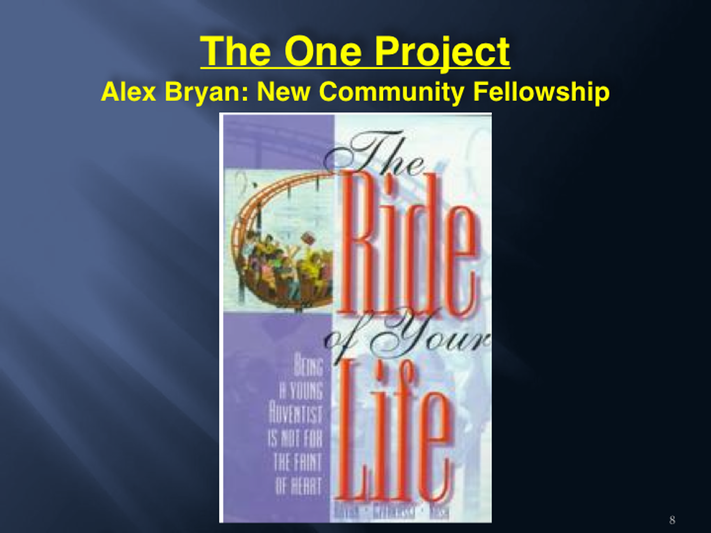
In 1996 Alex Bryan joined Andy Nash, then assistant Editor of the Adventist Review, and Victor Czerkasij, an admissions adviser at Southern Adventist University, to write The Ride of Your Life: Being a Young Adventist is not for the Faith of Heart. The front cover depicts a picture of “young Adventists” riding a roller coaster made up of church pews, hands in the air enjoying the ride with Hymnals flying out left and right, surrounding a “middle aged Adventist” sitting with arms crossed and frown on his face. What was their point by this cover? The first chapter Bryan contributed depicts his then recent trip of taking a load of teenagers to an amusement park for the day.
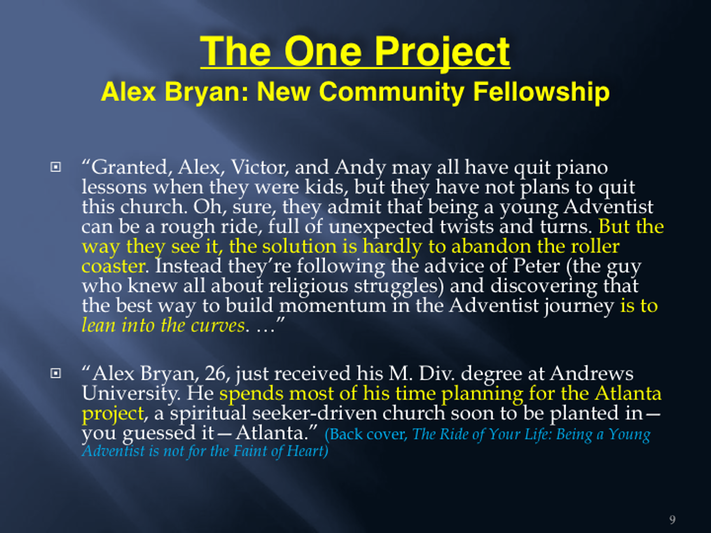
The back cover of the book has this to say about the book’s content and its authors. In 1996 Alex felt that the way to deal with the church was not to abandon it, but “lean into the curves.” Several years later it would seem that he abandoned that idea with his church plant and all its members.
In 1996 Alex Bryan joined Andy Nash, then assistant Editor of the Adventist Review, and Victor Czerkasij, an admissions adviser at Southern Adventist University, to write The Ride of Your Life: Being a Young Adventist is not for the Faint of Heart, published by Review and Herald. The front cover depicts a group of “young Adventists” riding a roller coaster made up of church pews, hands in the air, enjoying the ride with Hymnals flying out left and right, surrounding a “middle aged Adventist” sitting with arms crossed and frown on his face. What was their point? The first chapter Bryan contributed depicts his then recent trip of taking a load of teenagers to an amusement park for the day.
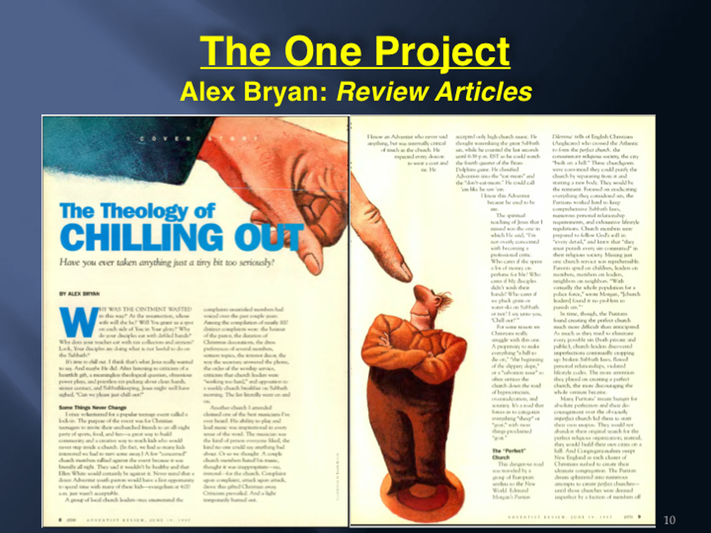
The front page article in the June 19, 1997 Adventist Review, was written by Alex Bryan soon after he started his Atlanta Project. He seems to take pot shots at those who might question the New Community Church plant and other churches like it across the North American Division. (http://www.adventistarchives.org/docs/RH/RH19970619-V174-25__C/index.djvu)
Many negative responses to Bryan’s article were in the letters section Aug. 21, 1997, pp. 2-3. (http://www.adventistarchives.org/docs/RH/RH19970821-V174-34__C/index.djvu?djvuopts&page=2)
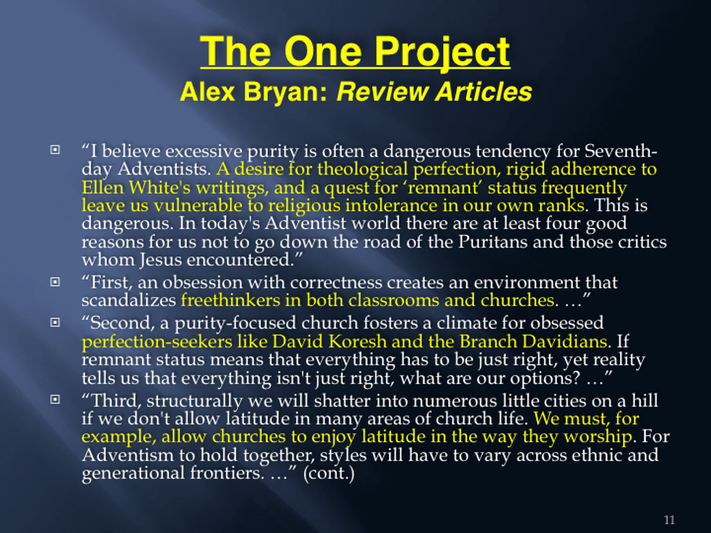
The front page article in the June 19, 1997 Adventist Review, was written by Alex Bryan soon after he started his Atlanta Project. He seems to take pot shots at those who might question the New Community Church plant and other churches like it across the North American Division.
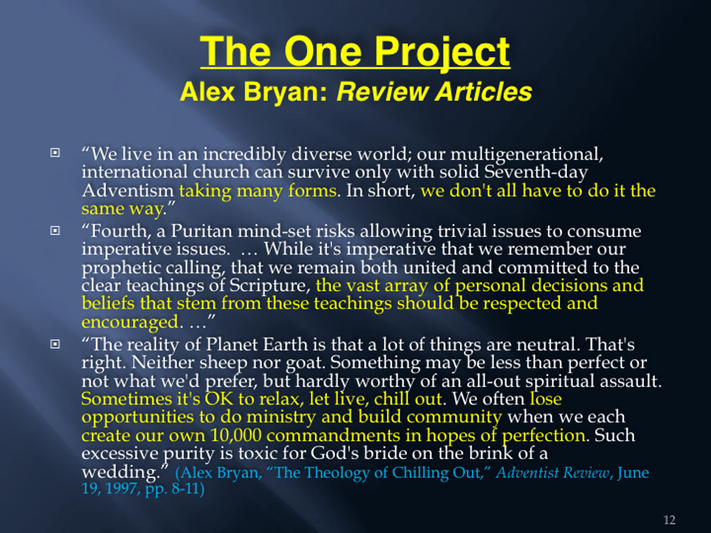
Within a couple years Bryan’s church plant left the Adventist organization after hundreds of thousands of dollars being put into it. Where are the Review articles that explain what went wrong and how in the future we can expect a change?
Many negative responses to Bryan’s article were in the “letters” section of the Review, Aug. 21, 1997, pp. 2-3. http://www.adventistarchives.org/docs/RH/RH19970821-V174-34__C/index.djvu?djvuopts&page=2
In an Review editorial (Sept. 19, 1997, p. 2), William Johnsson called on readers to listen to Alex: “Alex Bryan, who wrote the June 19 cover story, ‘The Theology of Chilling Out,’ is 27 (he is a pastor), … Writers like Alex, Sarah, and assistant editor Andy Nash are leavening the church, doing us all good. Listen to what they are saying.” The question is, what kind of “leavening” was being done?
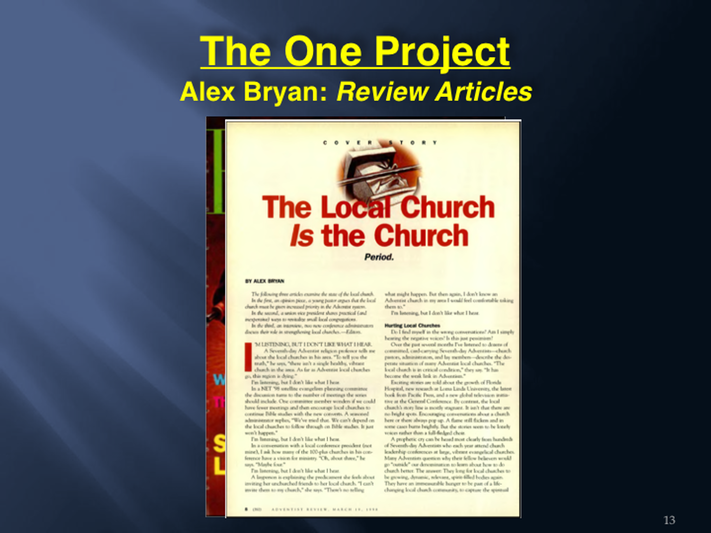
Here is another Alex Bryan article in the March 19, 1998 Adventist Review: “The following three articles examine the state of the local church. In the first, an opinion piece, a young pastor argues that the local church must be given increased priority in the Adventist system. In the second, a union vice president shares practical (and inexpensive) ways to revitalize small local congregations. In the third, an interview, two new conference administrators discuss their role in strengthening local churches.—Editors.” The views that Alex expressed seemed to take fruition several years later when his church plant separated from the denomination partly over the issue of tithe.
As a side note we should ask ourselves what the result has been of this newer approach of the Adventist Review in the 1990s, in publishing conflicting articles to help stimulate “conversation”?
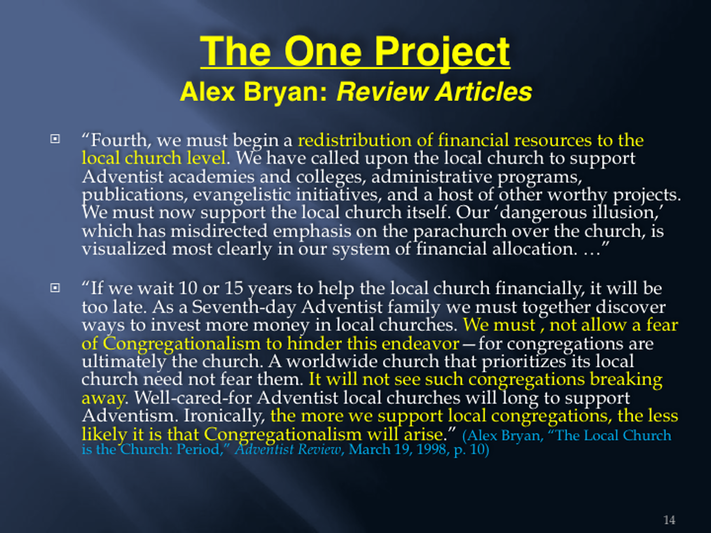
Here is another Alex Bryan article in the March 19, 1998 Adventist Review: “The following three articles examine the state of the local church. In the first, an opinion piece, a young pastor argues that the local church must be given increased priority in the Adventist system. In the second, a union vice president shares practical (and inexpensive) ways to revitalize small local congregations. In the third, an interview, two new conference administrators discuss their role in strengthening local churches.—Editors.” The views that Alex expressed seemed to take fruition several years later when his church plant separated from the denomination partly over the issue of tithe.
As a side note we should ask ourselves what the result has been of this newer approach of the Adventist Review in the 1990s, in publishing conflicting articles to help stimulate “conversation”?
Responses to this article were mixed in letters to editor (Review, May 21, 1998, p. 2; June, 1998, pp. 2-3).
Other articles by Alex Bryan in the Review, before his church plant and before leaving “denominational employment” where: Aug. 10, 1995, p. 11; Special Addition [May] 1996, pp. 32-33; July 18, 1996, p. 23; Sept. 19, 1996, pp. 21-22; Oct. 24, 1996, p. 21; Dec. 19, 1996, pp. 17-21; March 20, 1997, p. 22; July 24, 1997, p. 22; Sept. 18, 1997, p. 22; Jan. 15, 1998, p. 30; April 1998, p. 26; Jan. 21, 1999, p. 20; Nov. 25, 1999, p. 19; March 31, 2000, pp. 12-13; March 15, 2001, p. 20; June 12, 2001, pp. 12-16 [on sports]; Aug. 16, 2001, p. 20. Truly the Review was giving him a platform in which to speak his ideas.
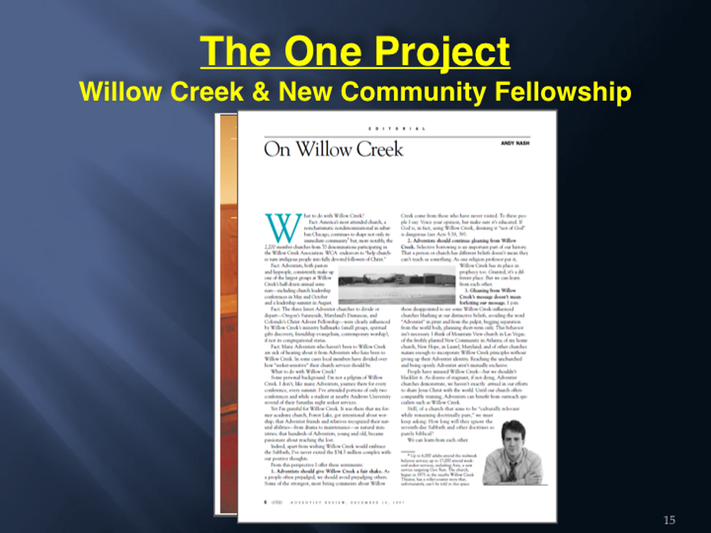
An article in the Dec. 18, 1997, Adventist Review by Andy Nash, commends Alex Bryan’s New Community Church for its association with Willow Creek and suggested that it was mature enough to keep its Adventist roots. Really? Did Andy Nash write a rejoinder after this? He later became editor of Adventist Today, 2008-2009. Did Adventist Today fit more his ideology?
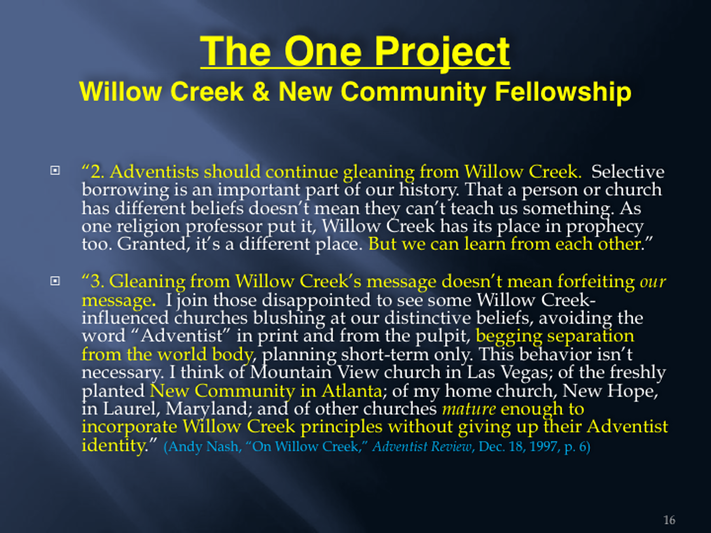
An article in the Dec. 18, 1997, Review by Andy Nash commends Alex Bryan’s New Community Church for its association with Willow Creek and suggested that it was mature enough to keep its Adventist roots. Really? Within a few years the very thing that Andy Nash claimed would not happen did in fact became the case with the New Community Church.
Pastor Larry Kirkpatrick made the following observation in 2004: “In the following month's Review, Andy Nash listed several break-aways: Oregon's Sunnyside. Maryland's Damascus. Colorado's Christ Advent Fellowship. It was most interesting that Nash closed his article urging us that while these churches had been influenced by Willow Creek, “Adventists Should Continue gleaning from Willow Creek” (Andy Nash, “On Willow Creek,” Adventist Review, December 18, 1997). His argument? The Mountain View Church eventually launched as a church plant the infamous Adventist Sunday Church experiment in Las Vegas, also known as the Mountain View Community church. In Atlanta, Georgia, The New Community was also presented as evidence of “other churches mature enough to incorporate Willow Creek principles without giving up their Adventist identity” (Ibid). However, the facts are that Alex Bryan's “New Community” church in Atlanta has since left the denomination and faded out of existence. The Adventist Sunday Church in Las Vegas, Nevada also failed, with no accessions to the Seventh-day Adventist Church to show and the pastor leaving the remnant church to lead worship in yet another obscure Sunday church. These are the examples of maturity?” (http://www.greatcontroversy.org/reportandreview/offshootpt1.php) (see slides below)
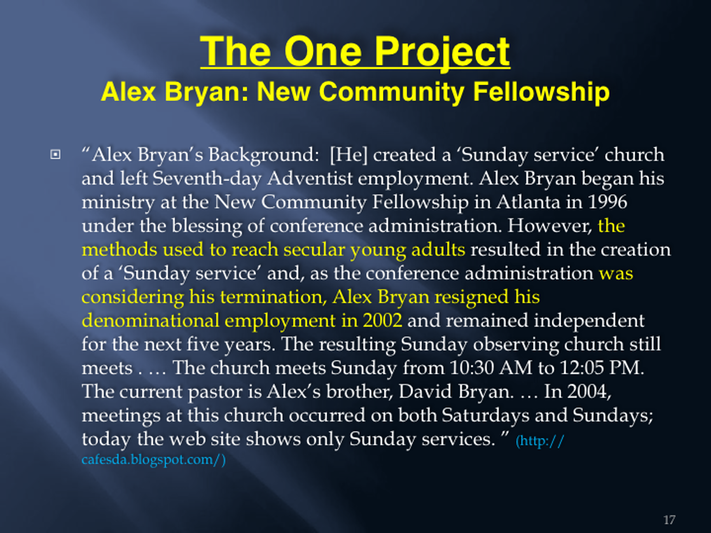
Yet it was only a few years and Bryan’s church left the denomination. More information is found on a Progressive SDA bloggers site (http://cafesda.blogspot.com/) It seems strange that not only the Georgia Cumberland Conference, but also other conferences since, appear to have no concern about Alex Bryan’s past. Wouldn’t there at least be some recognition that his church plant did in fact fail to achieve what he set out to achieve? Did his separation from Adventist employment result from a faulty philosophy of church planting and Evangelism? Does he still hold to the same or similar views as he seems to be pushing the Emerging Church ideas at WWU and through the One Project? The pages of the Review seem to have been silent. We would much more readily talk about all our good points, as we see them, than admit that we have made mistakes. Seems Revelation chapter 3 has something to say about this, if we would only listen.
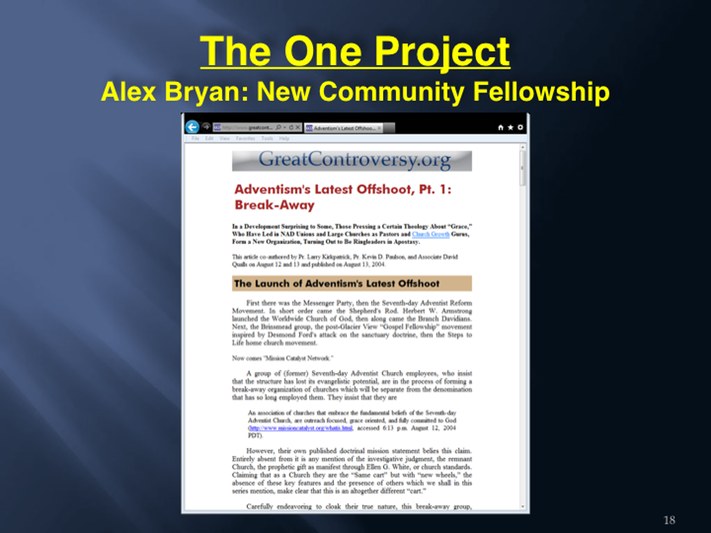
“Adventism's Latest Offshoot, Pt. 1: Break-Away” This article co-authored by Pastor Larry Kirkpatrick, Pastor Kevin D. Paulson, and Associate David Qualls on August 12 and 13 was published on August 13, 2004. (http://www.greatcontroversy.org/reportandreview/offshootpt1.php)
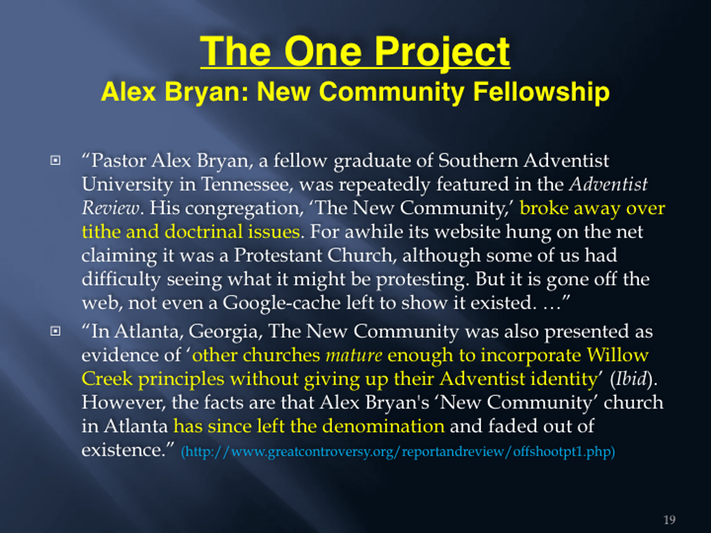
“Adventism's Latest Offshoot, Pt. 1: Break-Away” This article co-authored by Pastor Larry Kirkpatrick, Pastor Kevin D. Paulson, and Associate David Qualls on August 12 and 13 was published on August 13, 2004. (http://www.greatcontroversy.org/reportandreview/offshootpt1.php)
More of above article:
“For many years, certain among us have bent their best energies to reproducing Babylon's apparent successes but within the remnant church. First it was attempted to change our churches through bringing in the concept of varied worship styles. This was meant to justify the acceptance of Celebration worship as one of the worship style ‘options.’ It didn't work. It led only to turmoil and chaos. Eventually most realized that changing existing congregations was fighting an uphill battle. The emphasis shifted again, this time, to church planting.
At one point, William Johnsson waxed joyful in the Adventist Review how it was a miracle that although ‘Adventist worship varies from country to country, and within the countries,’ ‘With all the differences, we are one people. When we get together we worship the one God—in many voices, many colors, many ways’ (William Johnsson, “When We All Get Together,” Adventist Review, October 30, 1997, p. 12). But just one month later, even the Review would be compelled to present a different story.
Some of the break-aways no longer exist. Pastor Alex Bryan, a fellow graduate of Southern Adventist University in Tennessee, was repeatedly featured in the Adventist Review. His congregation, “The New Community,” broke away over tithe and doctrinal issues. For awhile its website hung on the net claiming it was a Protestant Church, although some of us had difficulty seeing what it might be protesting. But it is gone off the web, not even a Google-cache left to show it existed. So-called “Grace Place” in Colorado no longer even acknowledges its Seventh-day Adventist origin. The Damascus Road Community Church, another earlier break-away at least mentions its Adventist history if only in passing (On their website, click on “More About DRCC,” then on “History.”).
But a month later, Johnsson would make a series of interesting remarks. While indicating that he saw “no evidence for a trend” of break-away churches, he warned that we “need to remain alert if the Adventist body is to remain intact. Adventists may not face disintegration into disparate congregations right now, but the tenor of the times could bring us to that point ere long” (William Johnsson, “When the Family Splits,” Adventist Review, November 5, 1997, pp. 16-19). Even then Johnsson asked whether Adventist fascination with Willow Creek was not contributing to an influence in our midst toward congregationalism (Ibid., p. 17). Each time one of the “grace oriented” churches departs, we are told that the issue is not doctrinal. Yet we are often in the same articles told that there is some form of doctrinal problem, usually left unspecified.
In the following month's Review, Andy Nash listed several break-aways:
Oregon's Sunnyside.
Maryland's Damascus.
Colorado's Christ Advent Fellowship.
It was most interesting that Nash closed his article urging us that while these churches had been influenced by Willow Creek, “Adventists Should Continue gleaning from Willow Creek” (Andy Nash, “On Willow Creek,” Adventist Review, December 18, 1997). His argument? The Mountain View Church eventually launched as a church plant the infamous Adventist Sunday Church experiment in Las Vegas, also known as the Mountain View Community church. In Atlanta, Georgia, The New Community was also presented as evidence of “other churches mature enough to incorporate Willow Creek principles without giving up their Adventist identity” (Ibid). However, the facts are that Alex Bryan's “New Community” church in Atlanta has since left the denomination and faded out of existence. The Adventist Sunday Church in Las Vegas, Nevada also failed, with no accessions to the Seventh-day Adventist Church to show and the pastor leaving the remnant church to lead worship in yet another obscure Sunday church. These are the examples of maturity?
Who can understand the blindness and even mental incoherence of such insistence? The facts are, that no matter how many times it has been tried, there is today on planet earth not one example of a successful Seventh-day Adventist copycat of Willow Creek, or Saddleback, or the like that has ever become a mega-church. For decades misguided ministers and workers have tried it. Administrators have stood by awaiting the promised positive results. They've thrown a stack of dollars at it, but today, all attempts to photocopy have returned nothing but failure.”
(http://www.greatcontroversy.org/reportandreview/offshootpt1.php)
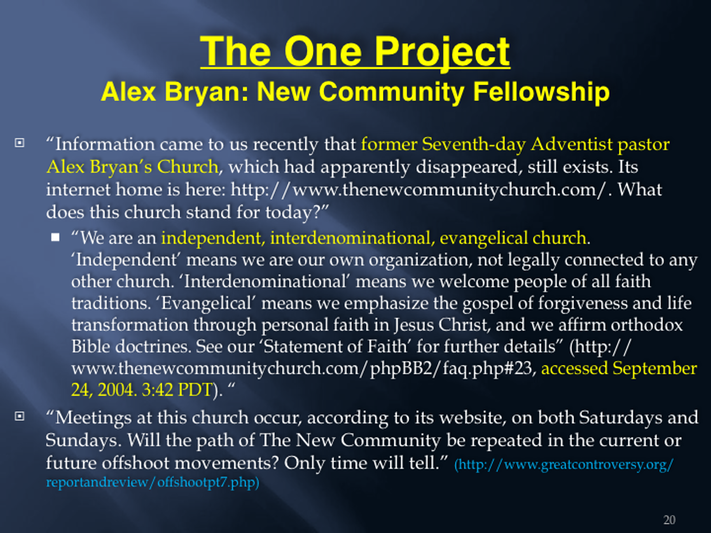
Pastor Larry Kirkpatrick published an update on September 28, 2004, on GreatControversy.org. Kirkpatrick quotes a statement from Alex Bryan’s church plant web site as it read in 2004, just two years after Bryan had separated from SDA employment. The church plant was obviously no longer associated with the Adventist church. So is it true that the ideas and philosophy of Willow Creek did not affect the church plant’s loyalties to the Adventist church? Has Bryant abandoned that philosophy or continued to follow it in other areas of his ministry but this time from within the church?
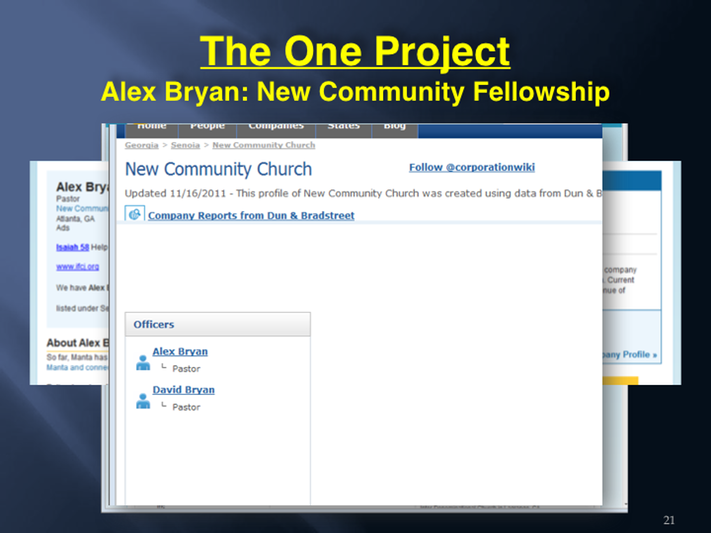
Note: Alex is not currently affiliated with the church he helped start, even though current websites, e.g. corporationwiki and Manta (as of Oct. 2012), list either Alex Bryan and David Bryan, or just Alex Bryan as the current pastor:
http://www.corporationwiki.com/Georgia/Senoia/new-community-church/88807405.aspx [two pictures, 2nd one is close up]
http://www.manta.com/g/mmdxjyp/alex-bryan [two pictures, 2nd one is close up]
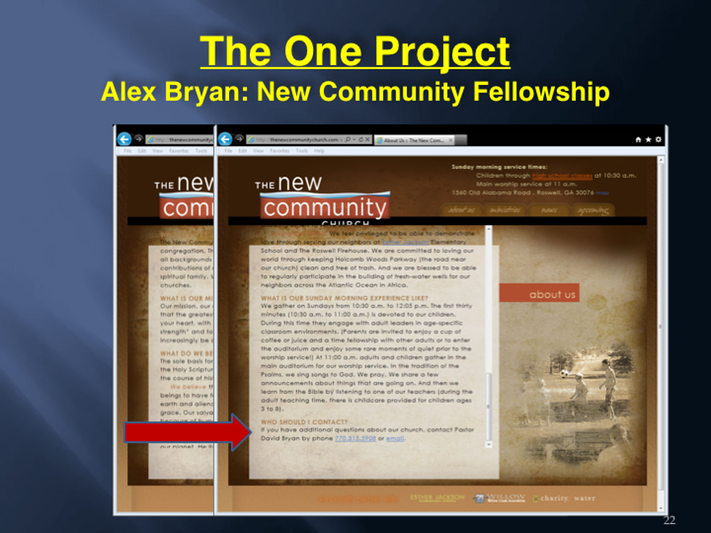
The current web site of The New Community Church lists Sunday service only, and still lists it as part of the Willow Creek Association which is where Alex got his ideas to begin with to start the church, and list David Bryan as the only pastor. The listed statement of beliefs does not suggest in anyway that the church is or ever was associated with the Adventist church. What happened to the “Adventist” members when the church went from an Adventist Church plant to a Sunday only non-denominational Church?
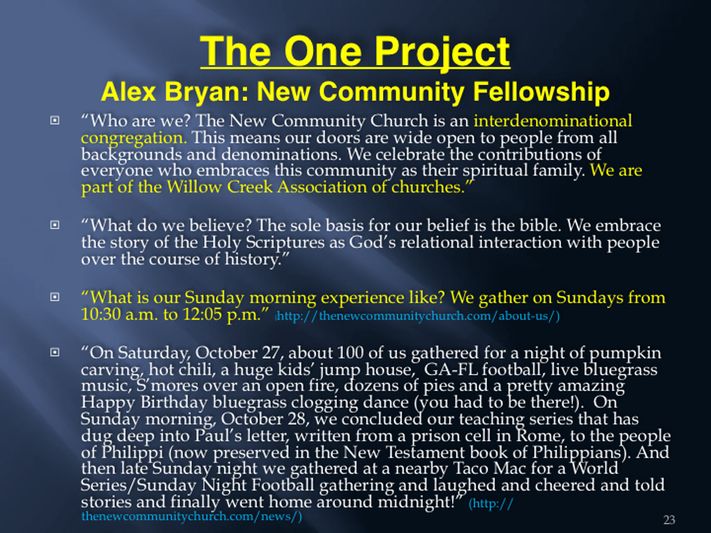
The current web site of The New Community Church lists Sunday service only, and still lists it as part of the Willow Creek Association which is where Alex got his ideas to begin with to start the church, and list David Bryan as the only pastor. The listed statement of beliefs does not suggest in anyway that the church is or ever was associated with the Adventist church. What happened to the “Adventist” members when the church went from an Adventist Church plant to a Sunday only non-denominational Church?
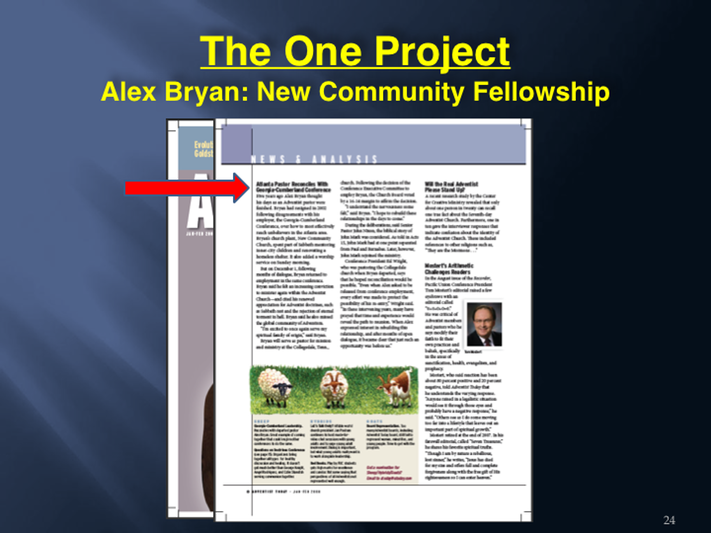
“Atlanta Pastor Reconciles With Georgia-Cumberland Conference”
When the Conference Executive Committee voted to bring Bryan back into employment and offered him the job at the Southern Adventist University Church (Campus Church), the Church board also voted whether to affirm this decision. It would appear that many of the church board were not comfortable with the idea. Who then was pushing this move, the Conference or the Church or Alex himself? Adventist Today, ran an article soon after Alex’s return to Southern Adventist University (“Atlanta Pastor Reconciles With Georgia-Cumberland Conference,” Adventist Today, Jan. Feb., 2008, p. 8), making it clear that there were some serious concerns even then.
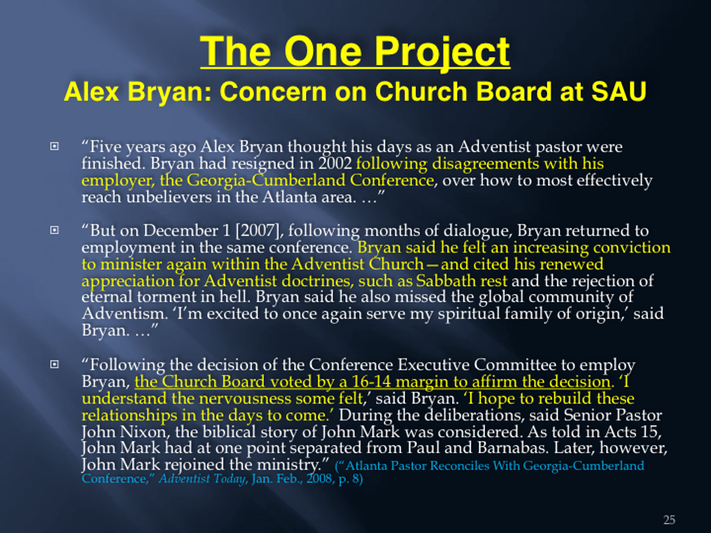
“Atlanta Pastor Reconciles With Georgia-Cumberland Conference”
When the Conference Executive Committee voted to bring Bryan back into employment and offered him the job at the Southern Adventist University Church (Campus Church), the Church board also voted whether to affirm this decision. It would appear that many of the church board were not comfortable with the idea. Who then was pushing this move, the Conference or the Church or Alex himself? Adventist Today, ran an article soon after Alex’s return to Southern Adventist University (“Atlanta Pastor Reconciles With Georgia-Cumberland Conference,” Adventist Today, Jan. Feb., 2008, p. 8), making it clear that there were some serious concerns even then.
Is the biblical story of John-Mark a correct parallel to the experience of Alex Bryan?
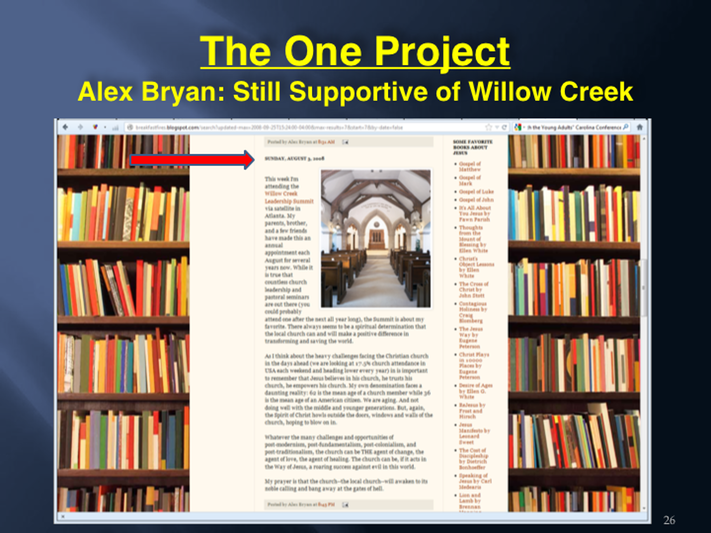
Yet on Aug. 3, 2008, only nine months after returning to church employment as associate pastor of the Campus Church, Alex posted on his blog that he was attending a Willow Creek Leadership summit, which is where he got his ideas to begin with for his New Community Church. Did he really learn from the failed church plant experiment? Was he really hoping “to rebuild these relationships in the days to come,” as he stated in the Adventist Today article listed above? Or was he just pushing on with his ideas as before but now from the inside? (http://breakfastfires.blogspot.com/search?updated-max=2008-09-25T15:24:00-04:00&max-results=7&start=7&by-date=false) [This blog post is no longer on the net]
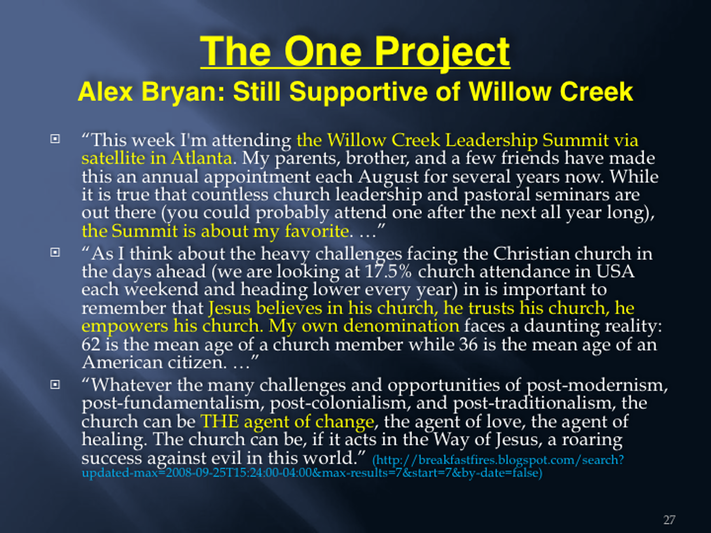
What does Alex mean by “Jesus believes in his Church” when discussing the conditions in the United States? Is there no difference between the Adventist Church and its calling and the other churches of the land?
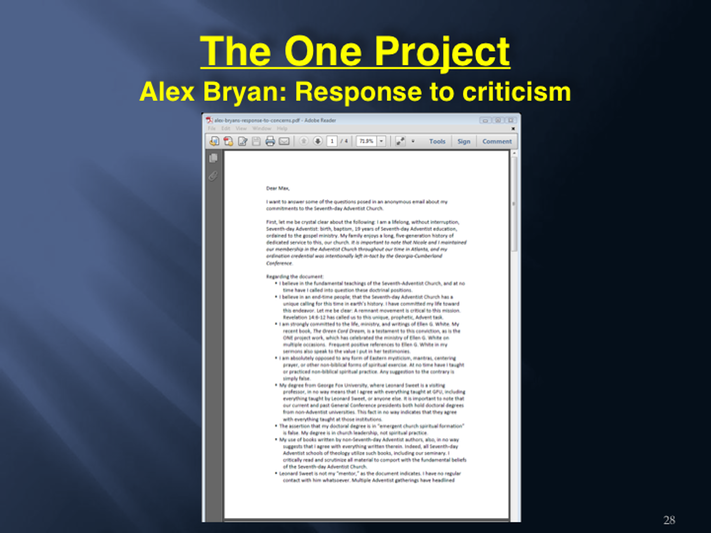
We will take a break in our chronological look at Alex’s history. In 2012 Alex responded to allegations about his Atlanta Experience following an “Anonymous” email of concern sent out because of his possible presidency at WWU. In a letter to Max Torkelson, North Pacific Union President, sometime in July, 2012, Alex defends his past. The reader will have to decide if Alex is really being forthright in his answers and honest with his own history.
Does the Atlanta project really have nothing to do with Theology? Was it the Conference that came up with the idea or Alex himself after attending Willow Creek? Was this experiment really in accordance with Ellen White’s counsel in 9T? Has Alex really abandoned the Willow Creek ideas and “discouraged this approach”? Was his church really committed to SDA theology? Defined by whom? Did the Church really remain SDA “doctrinally” and “culturally”? What about the 2004 statement describing what the church was about? Non-denominational? So they returned tithe up to the time they split away and then what? Was this not one of the reasons they spit, over funding issues as can be seen in Alex’s 1998 Review article?
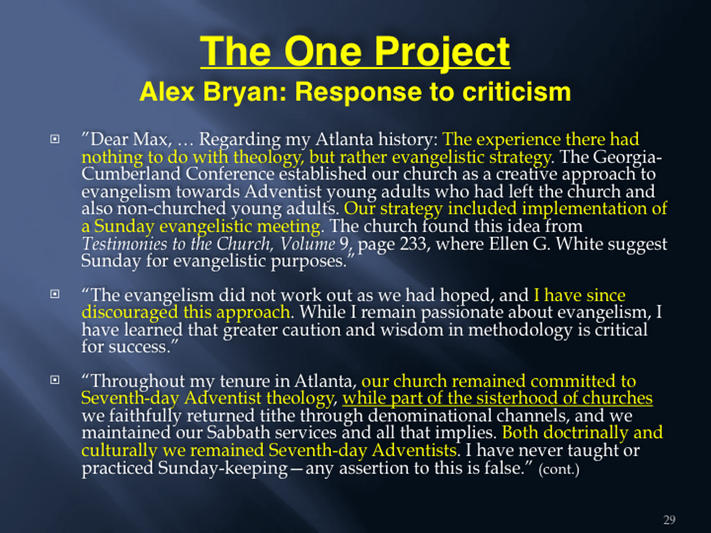
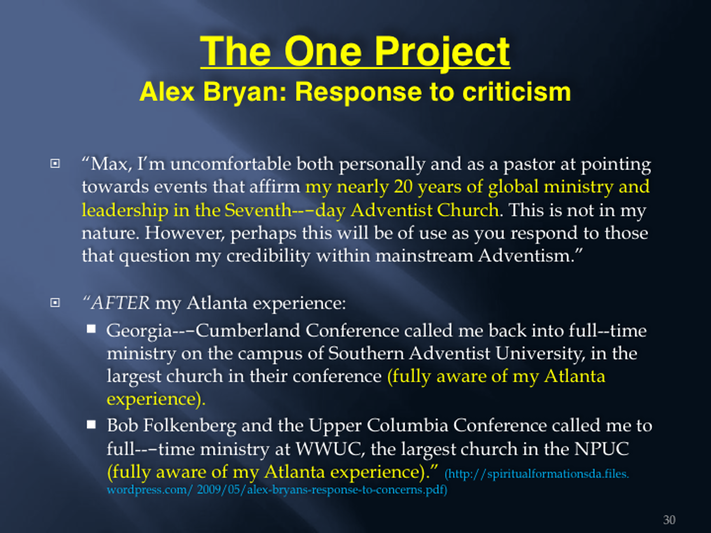
From 1997 through 2002 Alex was at the New Community Church in Atlanta running as an SDA church plant, however in 2002 he separated from the denomination. In late 2007 he came back to Denomination employment at Southern Adventist University. How can he say he has had nearly 20 years of leadership in the Seventh-day Adventist church. Although the Cumberland Conference invited him back, the church board was not so optimistic about his work. Alex fails to mention any of that in his letter to Max Torkelson. Bob Folkenberg invited him to come to WWU, and also as chairman of the search committee recommended him for WWU president. However, the WWU board voted that down by a 2/3 vote. Obviously some are not as comfortable with Alex among conference leaders as he portrays the matter.
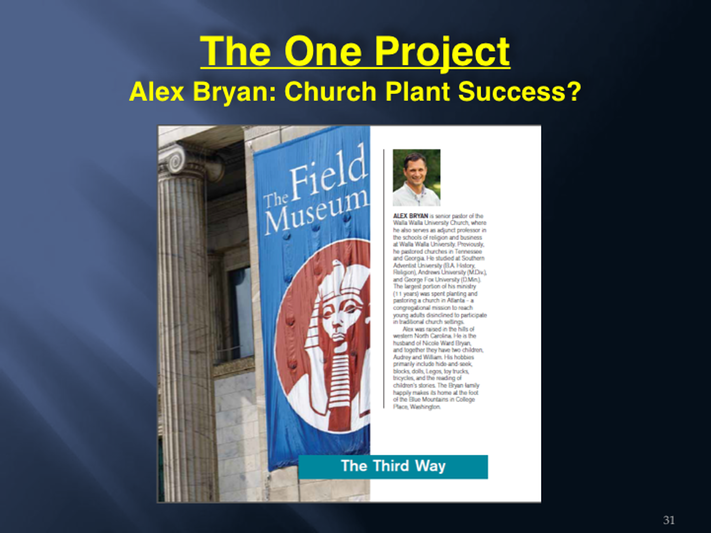
Even as late as 2013 however, the biographical sketch listed in The One Project’s Chicago booklet praises Alex’s church plant in Atlanta and makes no mention of its separation from the Adventist church nor it’s Willow Creek foundation. “The Third Way” is taken from Leonard Sweet’s Jesus Manifesto (see presentation 3).
(http://the1project.org/assets/documents/top_gathering_book_chicago_2013.pdf; page 28)
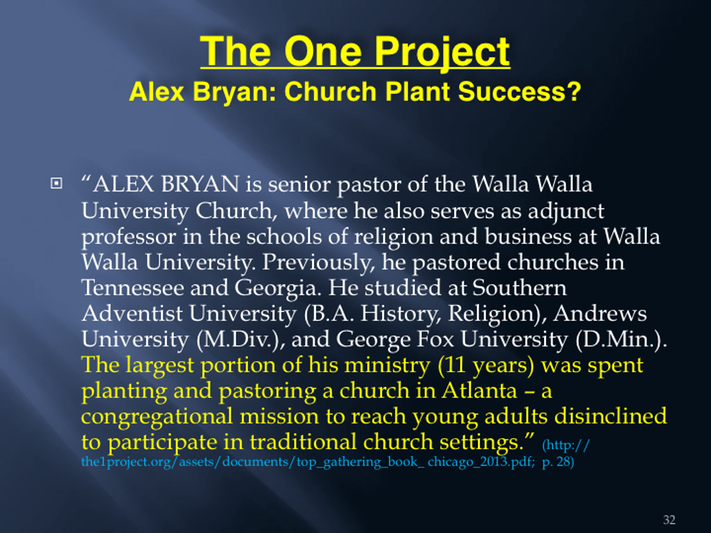
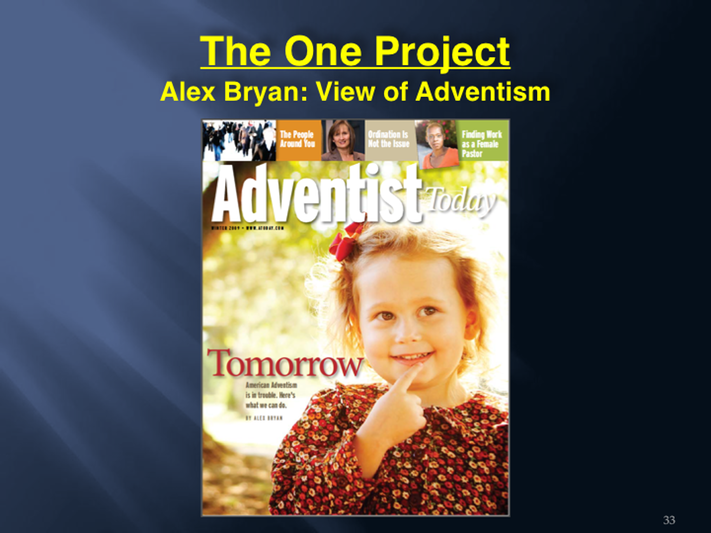
While back at Southern Adventist University in early 2009, Alex Bryan, who had not had any articles in the Review since his church plant left the denomination, wrote an article for Adventist Today, “Tomorrow: American Adventism is in trouble. Here’s what we can do.” (Andy Nash was then the editor). In this article he refers back to his 1998 Review article “The Local Church is the Church, Period.” Here he had expressed ideas that seem to have brought him trouble with his church plant in 2002. Alex also quotes from Leonard Sweet. (see below)
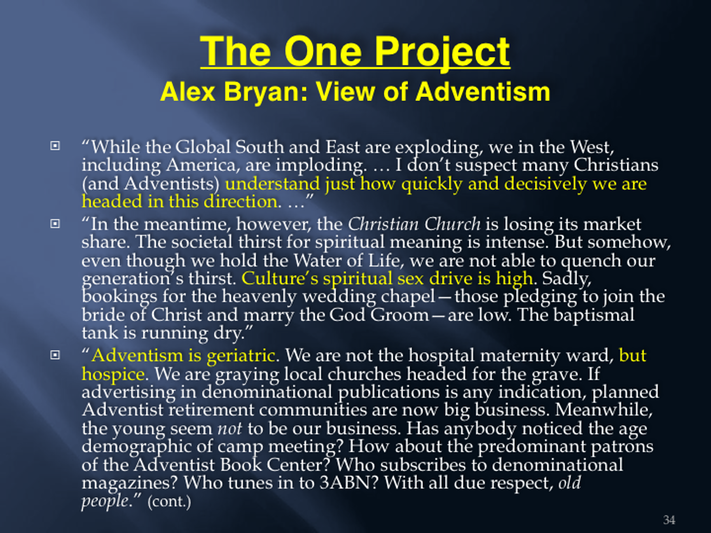
Alex starts his article by presenting an overly dismal picture of “Christianity” in North America. He quotes also from Leonard Sweet who along with many others in the Emerging Church movement have used this same approach to bring about “change”. Although the article has some valid points it would appear that Bryant is working off the same faulty logic that has been formed, not by great controversy Biblical understanding, but by Emerging Church movement rhetoric.
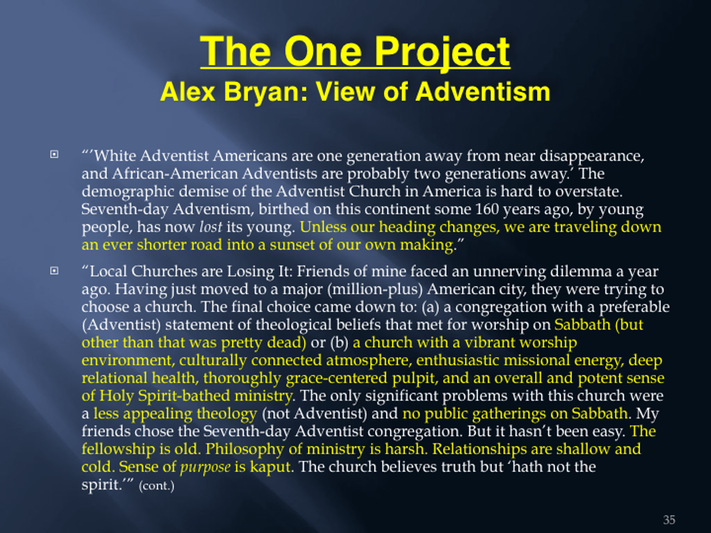
Alex continues along the same line in describing Adventism in general in North America. Its an either or choice. A dry lifeless Adventism, or a vibrant active non-Adventist church. Thus the motivation is being created for a great reformation and reorganization of Adventism.
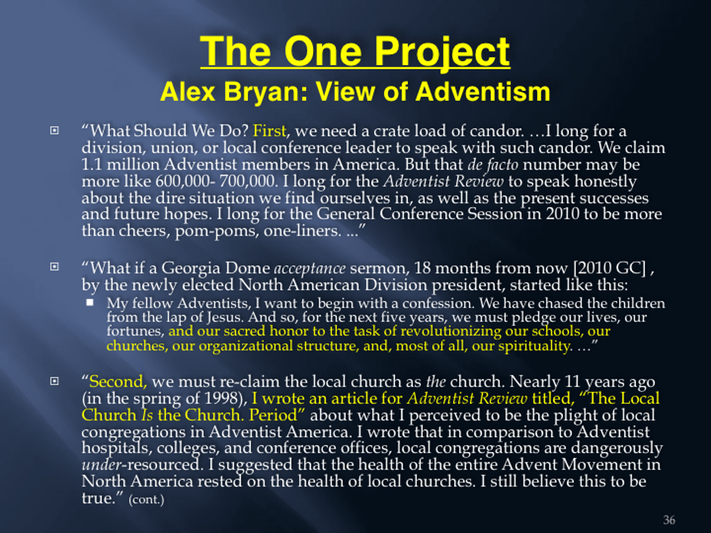
In this Adventist Today article Alex refers back to his 1998 Adventist Review article “The Local Church is the Church, Period.” Here he had expressed ideas that seem to have brought him trouble with his church plant in 2002.
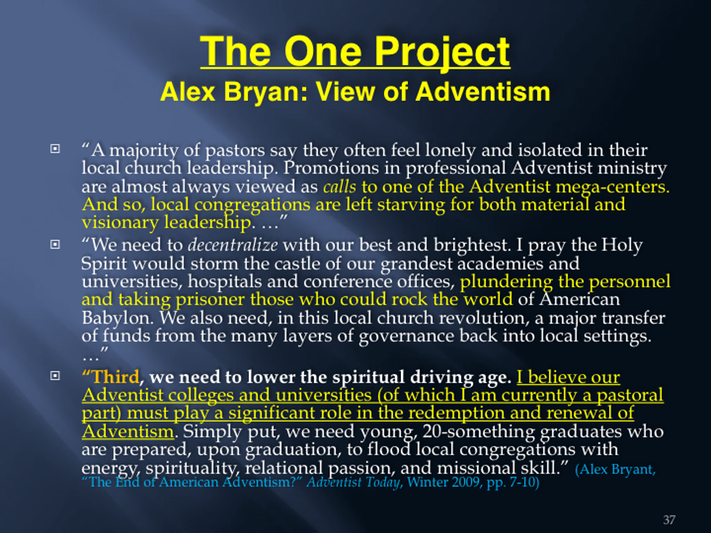
Again, Alex has some legitimate concerns of the problems with Adventism in North America. However, it is interesting to note that when he received a call to an “Adventist mega-center” he too did not turn it down in support of some smaller local congregation which he speaks up for in this 2009 article.
Also, notice his belief that the grand change and renewal of Adventism needs to come from the Universities. Although there is some truth in this, we might ask if our schools are of the order of “the schools of the prophets” or being turned in the direction of the schools of the world? Are young people being prepared to share the final message with the world, or fit into an Emerging Church culture that is seeking a one world religion of peace?
Alex’s call that every young person coming from our schools be prepared for missional service is excellent: “This is what I mean: every collegiate (and possibly high school) Adventist diploma ought to mean that the young person in cap and gown served a full year in domestic or international mission.” The problem, however, is how one defines mission. The New Community Church plant was based on a mission philosophy drawn from Willow Creek. Is there any difference from that mission and what our Adventist mission should be? Should there be? Does Alex see any difference? Based on his post graduate education what kind of missional thinking is he bringing to the table now? Emerging Church missional ideas?
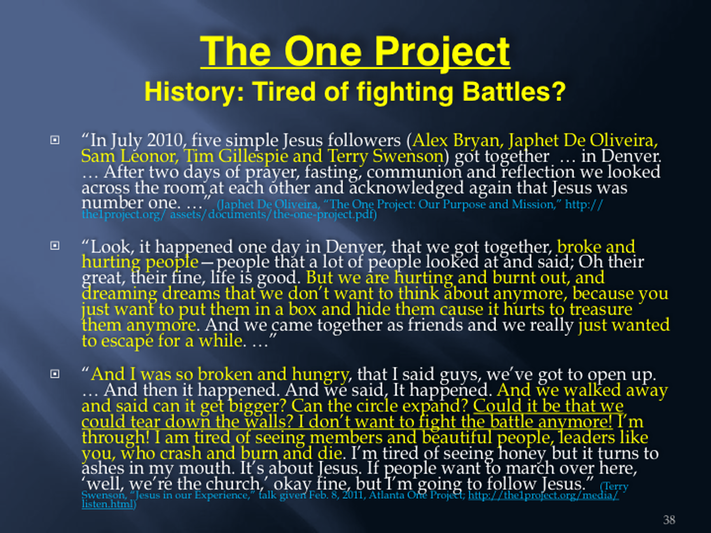
(Review Slide from presentation 5). It was only a few months after the above article was published that Alex and four other youth leaders met in Denver to ultimately plan The One Project. Yet, as we mentioned before, they were all obviously tired of “fighting battles.” The question is whether they were fighting the right battles, or rather fighting against the church (SDA) who’s foundation was built on something other than their false Emerging Church principles.
The last two paragraphs are taken from Terry Swenson’s talk in Atlanta, on Feb. 8, 2011 during the first large Project Gathering, we can gather that there were other past issues, battles and dreams that drove these men together to refocus their lives and their ministry. Although obviously very sincere we might wonder what battles they were tired of fighting.
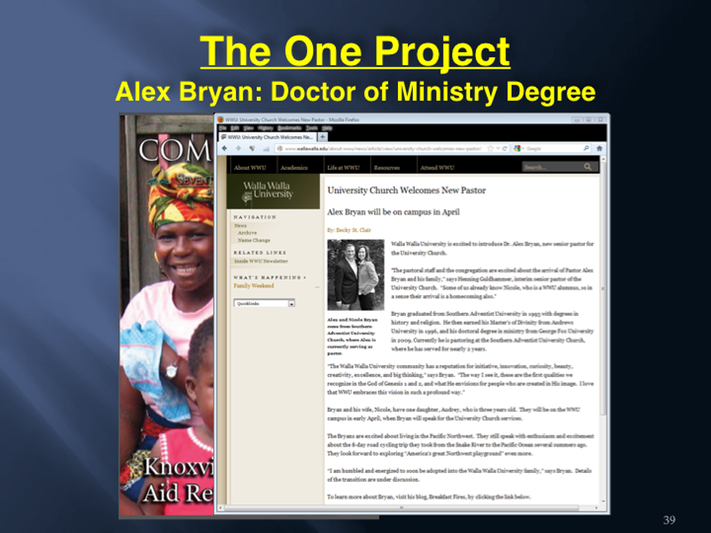
Now we will take a closer look at Alex Bryan’s educational background. When Alex was hired back into denominational work in 2007 he was then a doctor of Ministry student at George Fox University. The Georgia Cumberland Conference Communique did not state the specifics of his studies. When Alex Bryan was hired as WWU Church senior pastor in 2010, the WWU news listed that he had graduated in 2009 from George Fox University, but again the article did not mention specifics of his degree.
(http://www.gccsda.com/_static_content/ Communication/Communique/2007-11_Communique-web.pdf)
(http://www.wallawalla.edu/about-wwu/news/article/view/university -church-welcomes-new-pastor/)
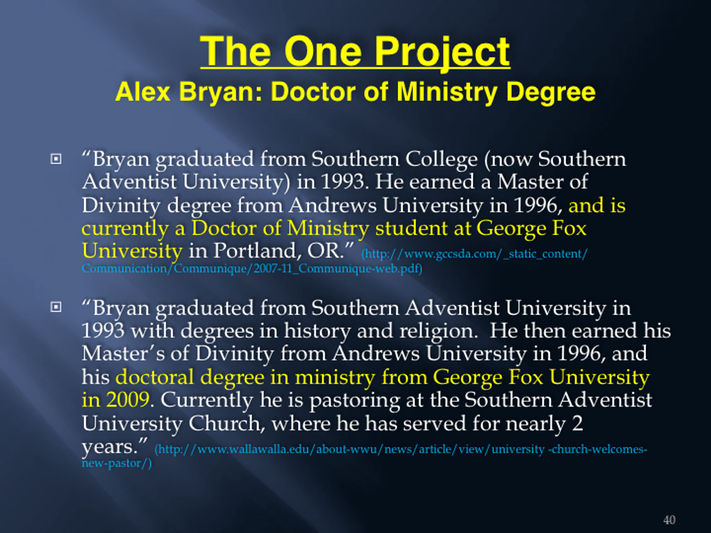
When Alex was hired back into denominational work in 2007 he was then a doctor of Ministry student at George Fox University. The Georgia Cumberland Conference Communique did not state the specifics of his studies. When Alex Bryan was hired as WWU Church senior pastor in 2010, the WWU news listed that he had graduated in 2009 from George Fox University, but again the article did not mention specifics of his degree.
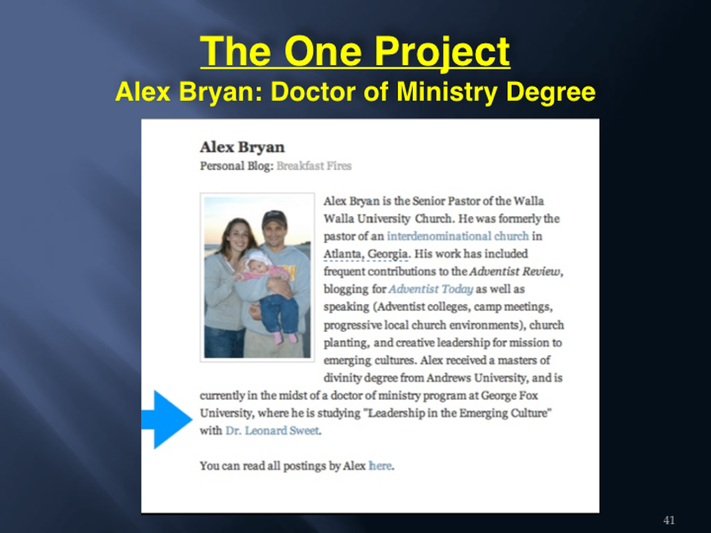
Taken from a power point presentation posted April 30, 2010, Slide 109 shows a statement possibly from Alex Bryan’s blog, most likely posted while at Southern University (not longer available online). Here it was made clear what his doctor of ministry program had been.
Note: Alex had not had an article in Adventist Review since 2001. But ran the article in Adventist Today Winter 2009 (above). Not the slightest indication that some of his past activities had led his church plant out of the church. Why? (http://www.slideshare.net/EmergingOmega/spiritually-experiencing-god-part-2)

As noted above, Alex responded to allegations about his history following an “Anonymous” email of concern sent out because of his possible presidency at WWU. In a letter to Max Torkelson, North Pacific Union President, sometime in July, 2012, Alex defends his past. The reader will have to decide if Alex is really being forthright in his answers and honest with his own history. The anonymous email stated: “b. Professional degree in emergent church spiritual formation. Received his Doctor of Ministry degree from George Fox University, under the direction of the spiritualist and Emerging Church leader Leonard Sweet.” (http://cafesda.blogspot.com/) Does Alex’s response really deal honestly with the issues?
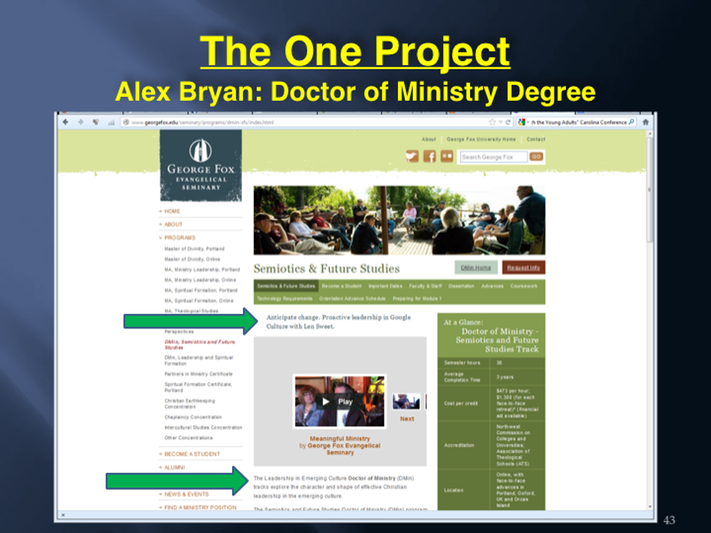
Review from presentation number 4:
“The Semiotics & Future Studies” is the same as “The Leadership in Emerging Culture Doctor of Ministry.” This course is offered under the direct tutelage or mentorship of Leonard Sweet. See Power point presentation number 4.
Leonard Sweet is “Currently the E. Stanley Jones Professor of Evangelism at Drew University, Madison, NJ and a Visiting Distinguished Professor at George Fox University, Portland, Oregon,…”
George Fox University which was founded by Quakers in 1885 and is located in Newberg Oregon, and has centers in Portland, Salem and Bosie ID. In 1996, the college merged with Western Evangelical Seminary to form George Fox University. Notable graduates include Richard Foster, and Dan Kimball, both big names in Emerging Church movement.
Doctor of Ministry
George Fox offers 3 Doctor of Ministry programs:
DMin in Leadership and Global Perspectives
DMin in Leadership and Spiritual Formation
DMin in Semiotics and Future Studies ( or The Leadership in Emerging Culture Doctor of Ministry)
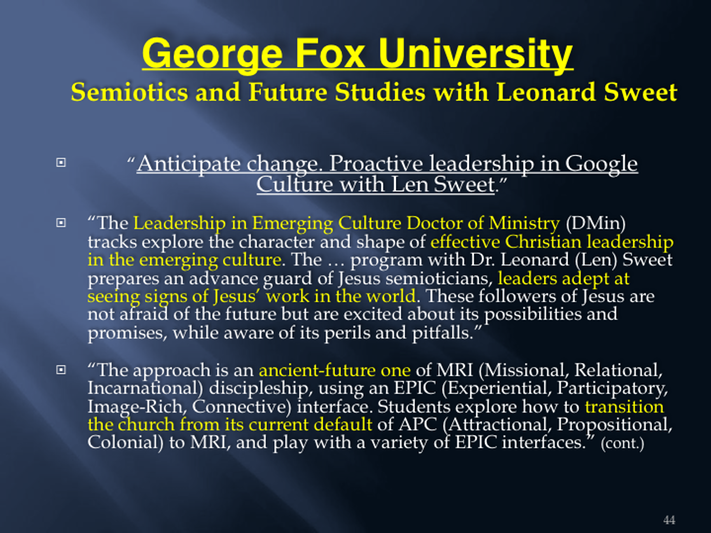
Review from presentation number 4:
The Leadership in Emerging Culture Doctor of Ministry (DMin), another name for Semiotics and Future Studies, is led by Leonard Sweet.
“Anticipate Change” is the heading on the web listing of this course.
Definition of SEMIOTICS: “a general philosophical theory of signs and symbols.” Leonard Sweet has been the primary person to make this word popular in the Emerging Church movement. He states that he bases it on Mat 16:3 “He answered and said unto them, When it is evening, ye say, It will be fair weather: for the sky is red. And in the morning, It will be foul weather to day: for the sky is red and lowring. O ye hypocrites, ye can discern the face of the sky; but can ye not discern the signs of the times?” The Greek word is “sēmeion” which means: “an indication, especially ceremonially or supernaturally: - miracle, sign, token, wonder.” Sweet seems to use it as a term that describes himself and his cohorts and followers, who can see the signs in different religions, cultures and histories.
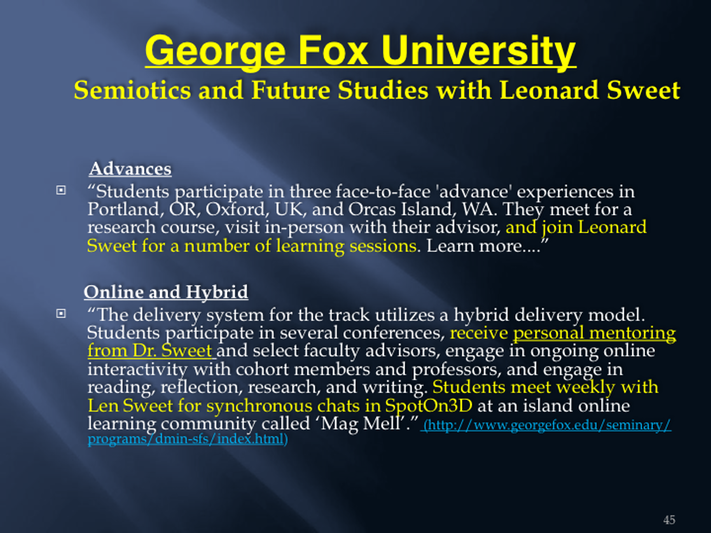
This particular course is described as being directly guided by Leonard Sweet even though he is a “visiting” professor. It would seem only obvious that Leonard Sweet would share many of his Emerging Church ideas in this program, which he has expressed in the nearly 50 books he has written over the past 20 years (See presentations 2-4). Remember that the Emerging Church is much more than just “spiritual formation”. The George Fox website states that “students … receive personal mentoring from Dr. Sweet.” Thus, according to the George Fox web site, Sweet would have been Alex Bryan’s “mentor” (at least one of them) in his doctoral program which lasted three years including his time at Southern Adventist University when he invited Sweet to speak there. (see slide below) Of course Alex did not need to be on the Portland campus for this program, but along with the other 3 One Project leaders took their DMin degrees while still leading out in their home SDA churches.
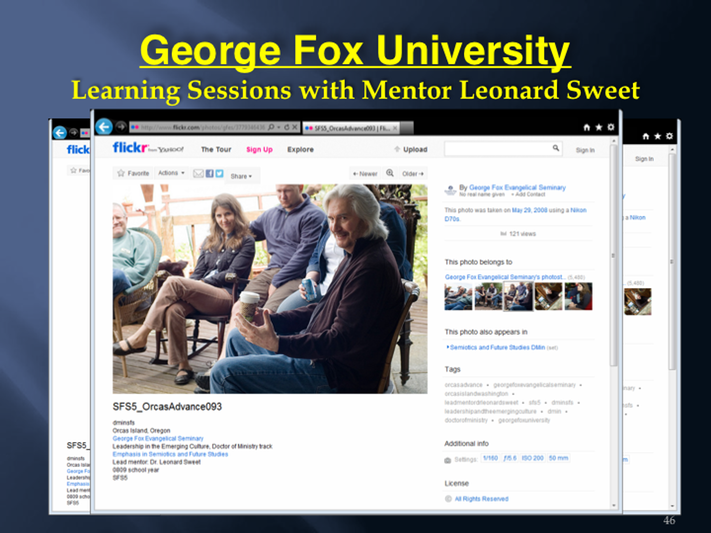
George Fox University posted pictures from one of the Learning Sessions with “lead mentor” Leonard Sweet. This was during the 2008/2009 school year. Pictures are from May 29 to 30, 2008, Orcas Advance. This took place at Leonard Sweet’s Orcas Island, OR/WA home. Alex Bryan attended this session soon after he was hired back at the Southern University Church. These pictures and explanations from George Fox University offer contradictory evidence against Alex Bryan and those who seek to defend him by stating that Leonard Sweet was not his mentor, and/or that Alex was not on the campus of George Fox University.
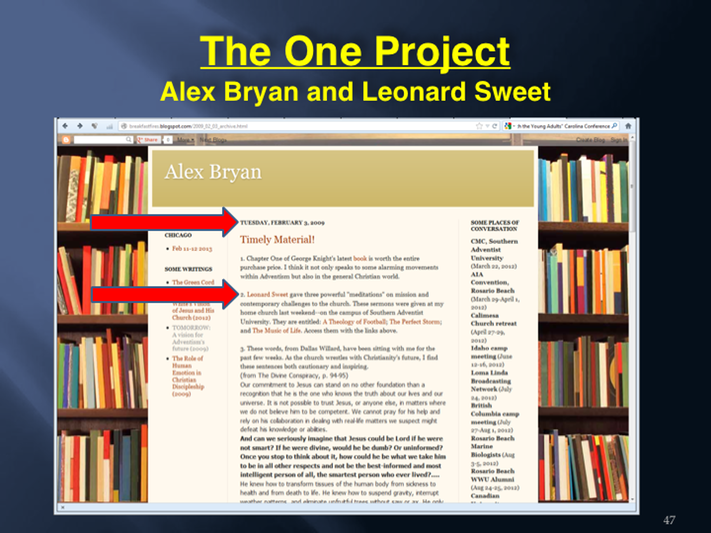
Only a little more than a year after coming back to Southern Adventist University Church, and near his Doctoral Ministry completion, Alex brought Leonard Sweet in for a weekend speaking engagement where Sweet spoke three times. On Alex’s own blog for Feb. 3, 2009, he mentions this event and even posts links to Sweet’s three sermons (“A Theology of Football”; “The Perfect Storm”; and “The Music of Life”). Only one of the sermons is still available on line, “A Theology of Football,” delivered Sabbath, Jan. 31, 2009. (https://www.box.com/shared/2xqso2joaf). [All this material has since been removed from his blog]
Some see no problem with Alex inviting Sweet Southern Adventist University because Sweet “has been an invited speaker at General Conference, North American Division, union conference, and local conference gatherings.” (http://www.scribd.com/doc/99405825/Response-to-the-Anonymous-Letter-1) But as we will see, several of the One Project leaders have played a part in inviting Sweet to our University campuses to introduce him and his books to our young people.
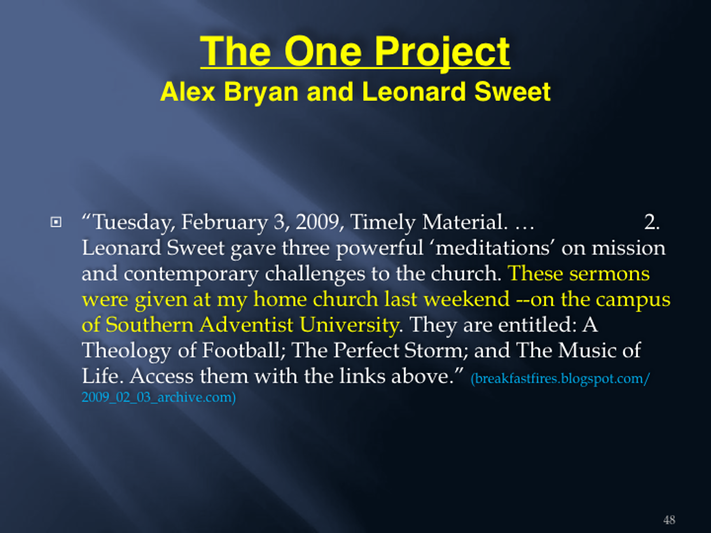
Some see no problem with Alex inviting Sweet Southern Adventist University because Sweet “has been an invited speaker at General Conference, North American Division, union conference, and local conference gatherings.” (http://www.scribd.com/doc/99405825/Response-to-the-Anonymous-Letter-1) But as we will see, several of the One Project leaders have played a part in inviting Sweet to our University campuses to introduce him and his books to our young people.
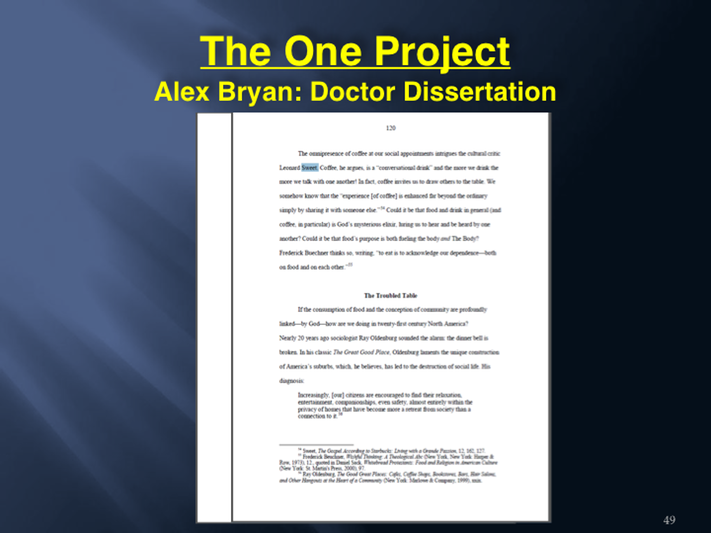
Alex Bryan’s doctoral ministry thesis was finished in March 2009, while he was at the campus church at Southern Adventist University. He quoted from Sweet several times in his dissertation along with many other well known Emerging Church gurus.
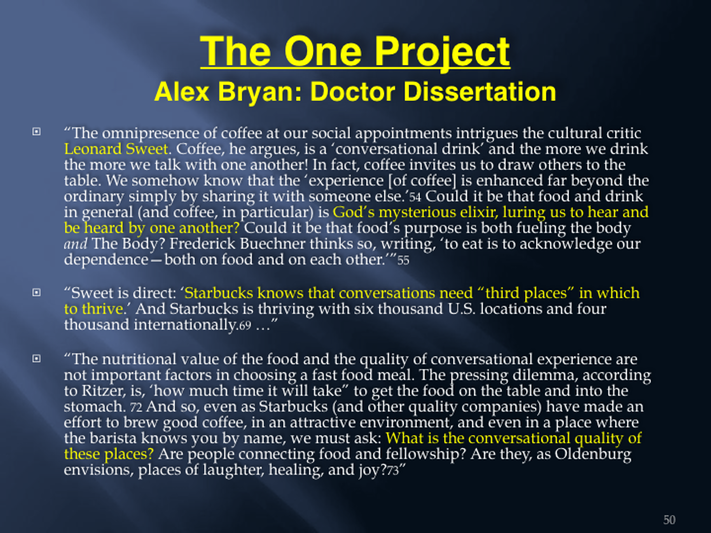
Alex Bryan’s doctoral dissertation was finished in March 2009, while pastoring at Southern Adventist University Church. He quoted from Sweet several times in his dissertation along with many other well known Emerging Church gurus. For more on Sweets books see presentations 2, 3, and 4.
[54] Sweet, The Gospel According to Starbucks: Living with a Grande Passion, 12, 162, 127.
[55] Frederick Beuchner, Wishful Thinking: A Theological Abc (New York, New York: Harper & Row, 1973), 12., quoted in Daniel Sack, Whitebread Protestants: Food and Religion in American Culture (New York: St. Martin's Press, 2000), 97.
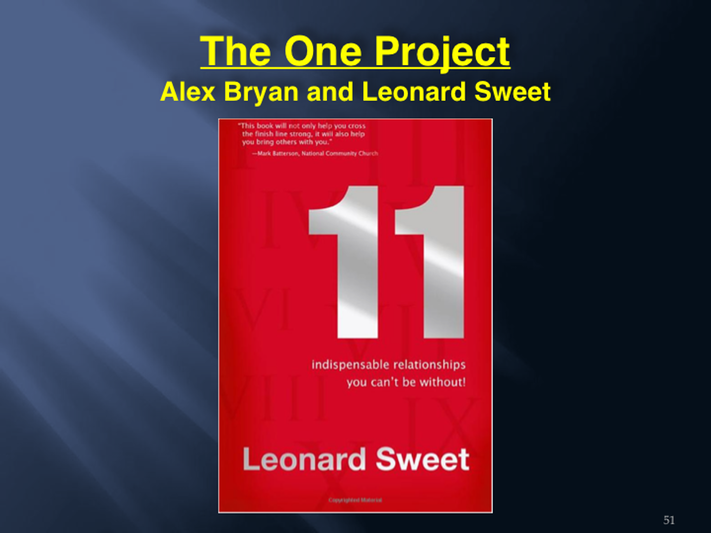
Leonard Sweet listed Alex Bryan as his doctoral student in 2007 in his book 11: Indispensable Relationships You Can’t Be Without. Its possible that there was another Alexander Bryan that was taking their D Min degree the same year at George Fox University, but it certainly would appear that this is speaking of “Alex Bryan.”
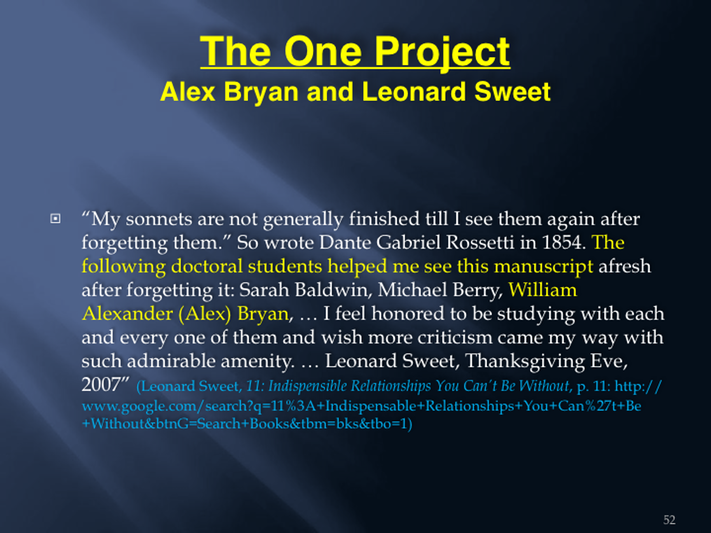
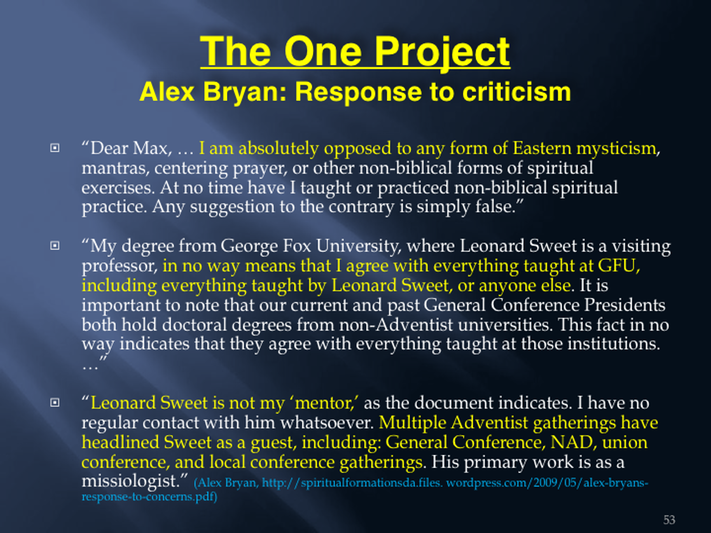
As listed above, Alex responded to allegations about his association with Leonard Sweet in a letter to Max Torkelson, North Pacific Union President, sometime in July, 2012, following an “Anonymous” email of concern for his possible presidency at WWU. The reader will have to decide if Alex is really being forthright in his answers and honest with his own history. The document that Alex responded to stated: “b. Professional degree in emergent church spiritual formation. Received his Doctor of Ministry degree from George Fox University, under the direction of the spiritualist and Emerging Church leader Leonard Sweet. c. Invited his mentor, a self-admitted spiritualist and leader of the emerging church movement, Leonard Sweet, to Southern Adventist University, to speak for Vespers Jan '09. …” (http://cafesda.blogspot.com/)
The fact is that Sweet was his “mentor” during his 3 year doctoral ministry program at George Fox University, which included Alex’s time at the Campus church at Southern Adventist University, when he invited Sweet to come and speak to the students and faculty. It should be remembered that there is much more to Sweet and the Emerging Church movement than pantheistic ties, spiritual formations and centering prayer. The Emerging Church has many other identifying factors that make it incompatible with Protestant Christianity and especially Adventism with the message that we have been given to share with the world.
The fact that Sweet has been invited to GC, NAD and other Union conferences, is very true, but very sad, and in no way justifies his being invited to Southern by Alex Bryan. How far do we take these lines of thinking? Baal worship is baal worship regardless of where it is practiced.
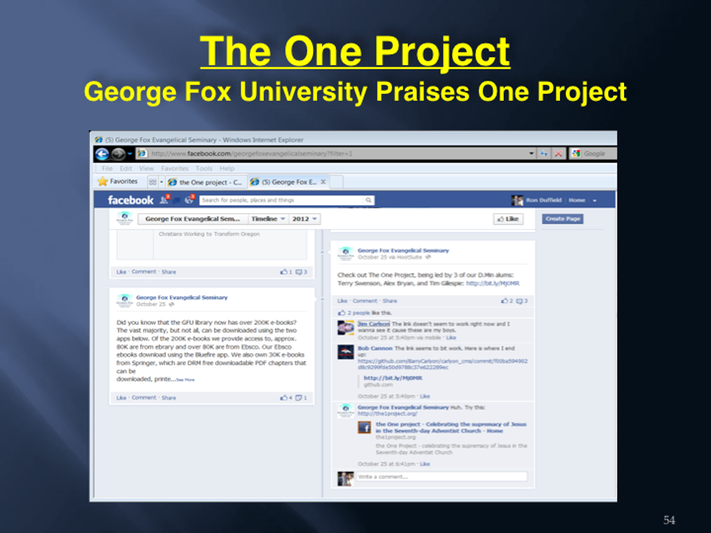
ON October 25, 2012, George Fox Evangelical Seminary posted a statement about three of their graduate’s accomplishments in leading out in The One Project. It seems clear that this is seen as a success for George Fox University. Terry Swenson, Alex Bryan and Tim Gillespie were all named. They obviously forgot to mention Sam Leonor. It would seem that if these alumnus of George Fox were promoting a truly Adventist program through the One Project that George Fox would not brag about it.?.?
(https://www.facebook.com/georgefoxevangelicalseminary/timeline?filter=1)
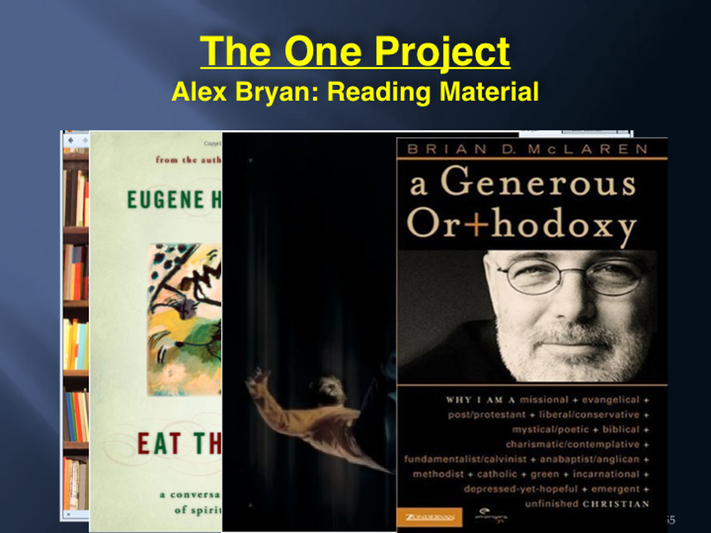
Now we will take a look at Alex Bryan and his recommended reading material. On August 7, 2007, even before returning to Adventist employment from his breakaway church plant to Campus church at Southern Adventist University, Alex commented on recent books he had read and highly recommended them on his blog. (http://breakfastfires.blogspot.com/search?updated-max=2007-11-10T10:40:00-05:00&max-results=7&start=21&by-date=false) [This post has since been removed from his blog]
Eugene H. Peterson, Eat This Book: A Conversation in the Art of Spiritual Reading (2006)
Rob Bell, Velvet Elvis: Repainting the Christian Faith (2005).
Brian McLaren, A Generous Orthodoxy (2006)
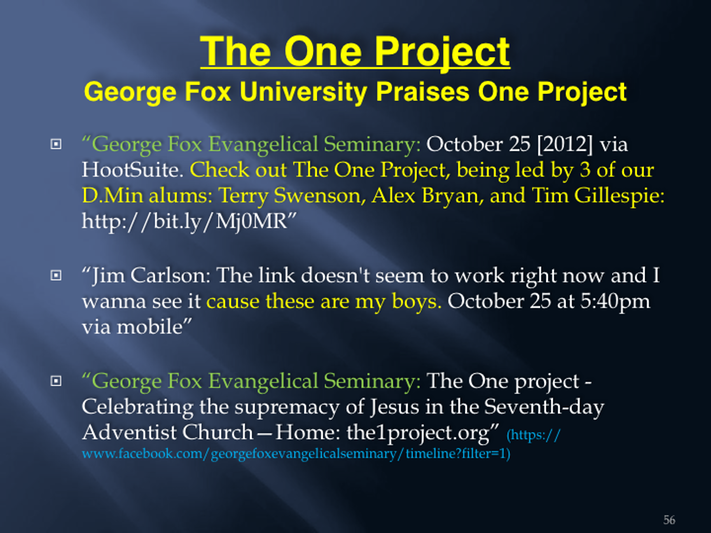
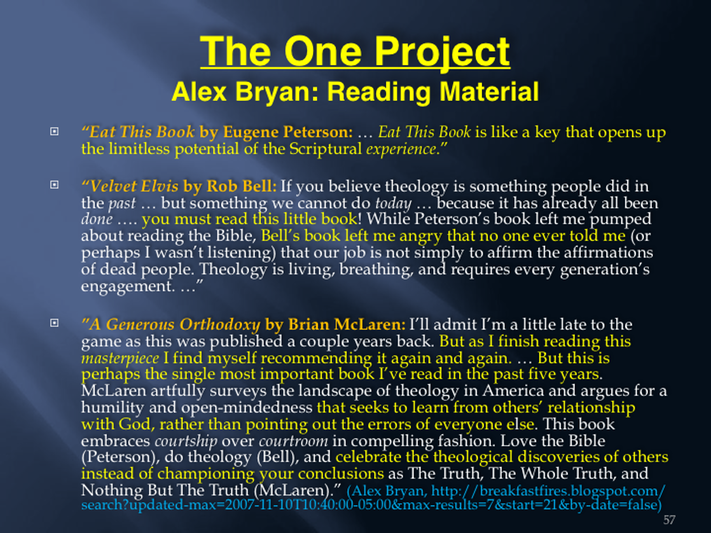
On August 7, 2007, even before returning to Southern Adventist University, Alex comments on recent books he had read and recommends them.
Eugene H. Peterson, Eat This Book: A Conversation in the Art of Spiritual Reading (2006)
Rob Bell, Velvet Elvis: Repainting the Christian Faith (2005).
Brian McLaren, A Generous Orthodoxy (2006)
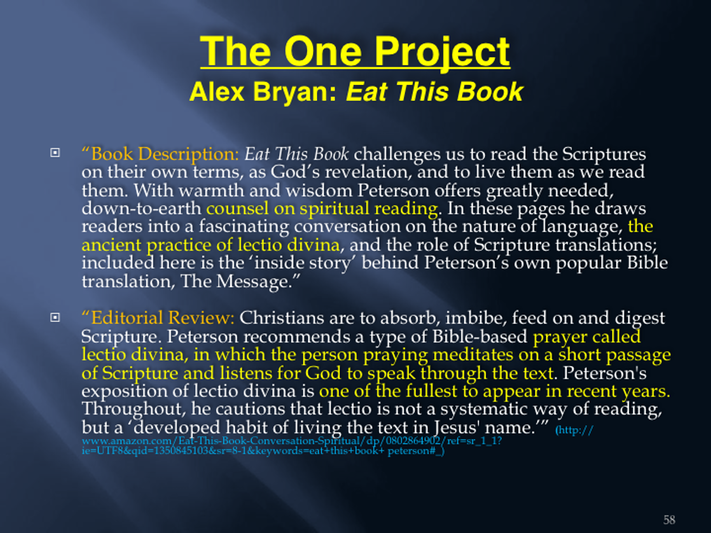
Eugene H. Peterson, Eat This Book: A Conversation in the Art of Spiritual Reading (2006). The first book recommended on Alex’s blog in 2007.
Official book description and editorial review as found on Amazon.com.
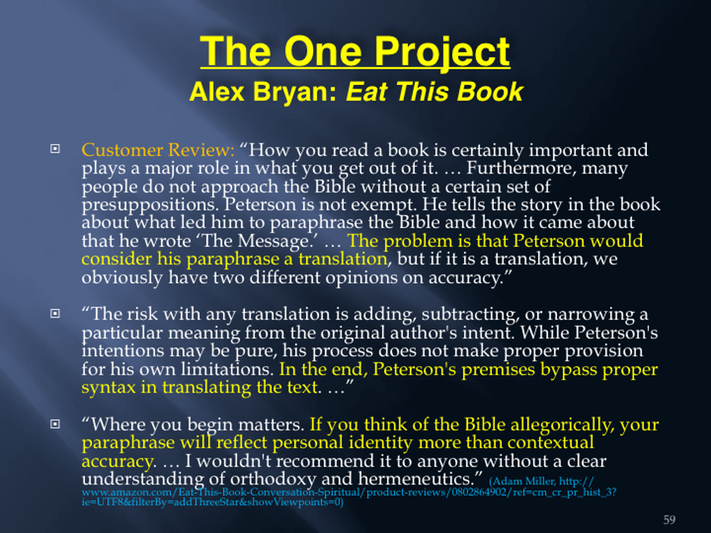
Eugene H. Peterson, Eat This Book: A Conversation in the Art of Spiritual Reading (2006) The first book recommended on Alex’s blog in 2007.
This is taken from a three star book review. Readers Responses are mixed. Even those who would overall recommend Peterson’s book see problems with his starting premise.
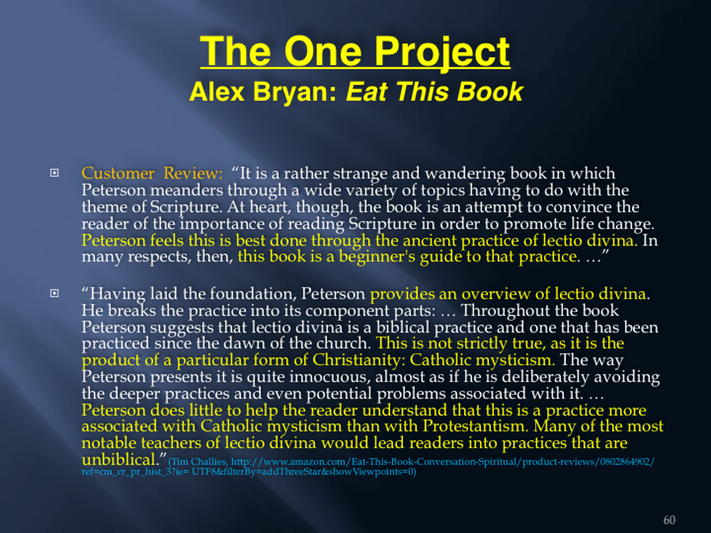
Eugene H. Peterson, Eat This Book: A Conversation in the Art of Spiritual Reading (2006) The first book recommended on Alex’s blog in 2007.
This is taken from another three star review. Readers Responses are mixed. Notice Peterson’s reliance on Lectio Divina.
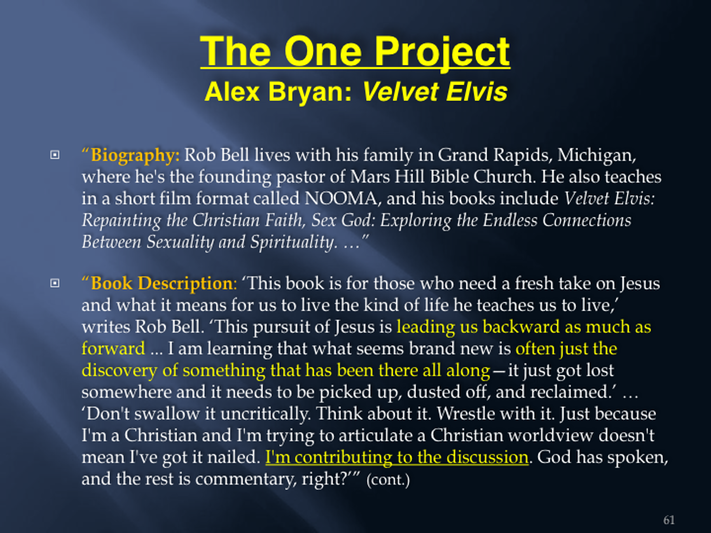
Rob Bell, Velvet Elvis: Repainting the Christian Faith (2005). The second book recommended on Alex’s blog in 2007.
Notice the idea that this is “contributing to the discussion.”
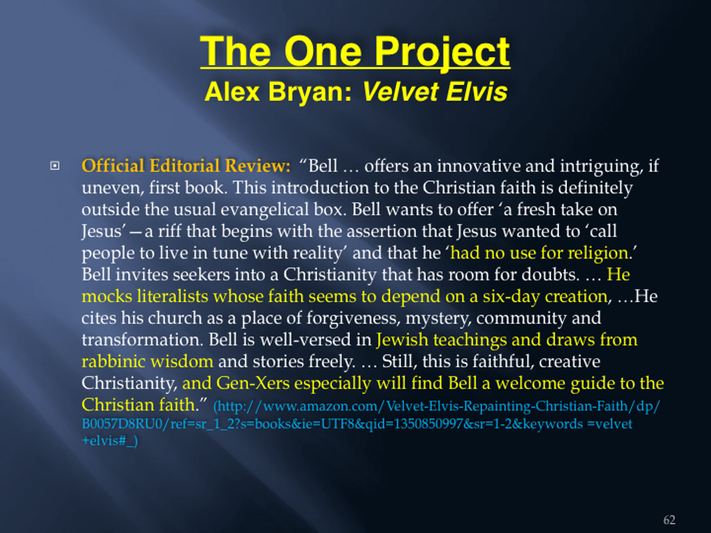
Rob Bell, Velvet Elvis: Repainting the Christian Faith (2005). The second book recommended on Alex’s blog in 2007.
This official Editorial Review posted by the book publishers on Amazon.com give and insight into the underlying philosophy of this book.
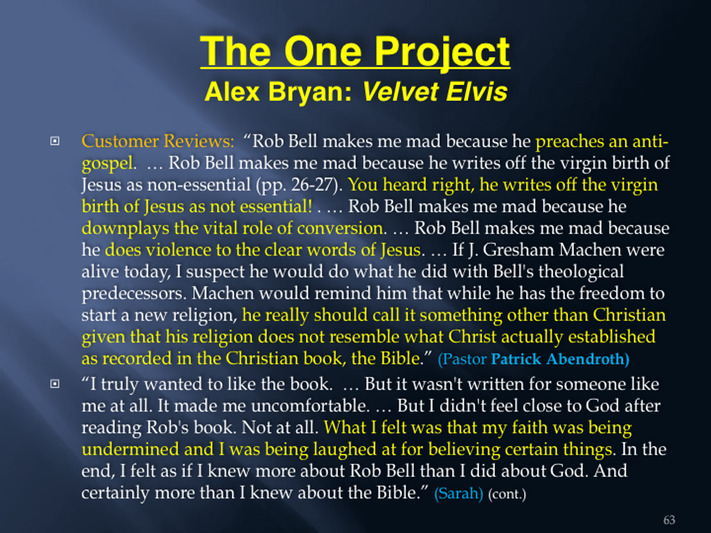
Rob Bell, Velvet Elvis: Repainting the Christian Faith (2005). The second book recommended on Alex’s blog in 2007.
There are 56 One star reviews, 37 Two star reviews, 27 Three star reviews. Clearly many people where concerned about this book.
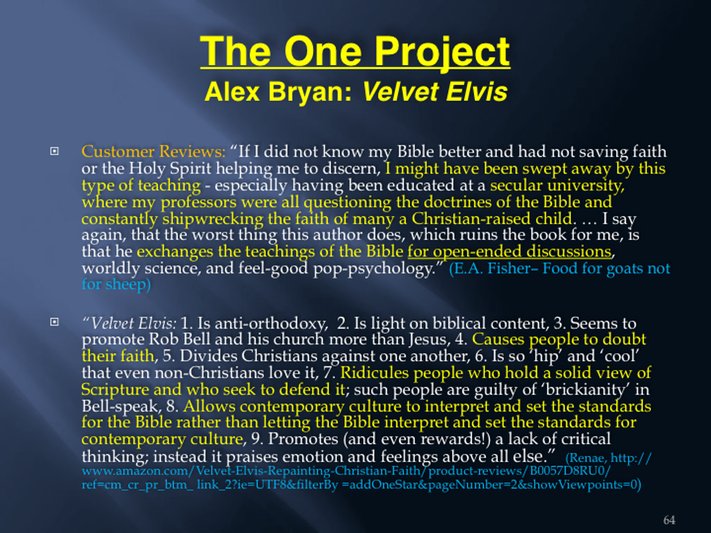
Rob Bell, Velvet Elvis: Repainting the Christian Faith (2005). The second book recommended on Alex’s blog in 2007.
Notice again the idea of “discussion” which falls into line with the idea of having a “conversation.”
“Conversations.” “Discussions.” “Dialog.” These are all words describing the way for tearing down the past/present and introducing the new. This is all part of the “Emerging Church” mode of operation not just “spiritual formations” or “centering prayer.”
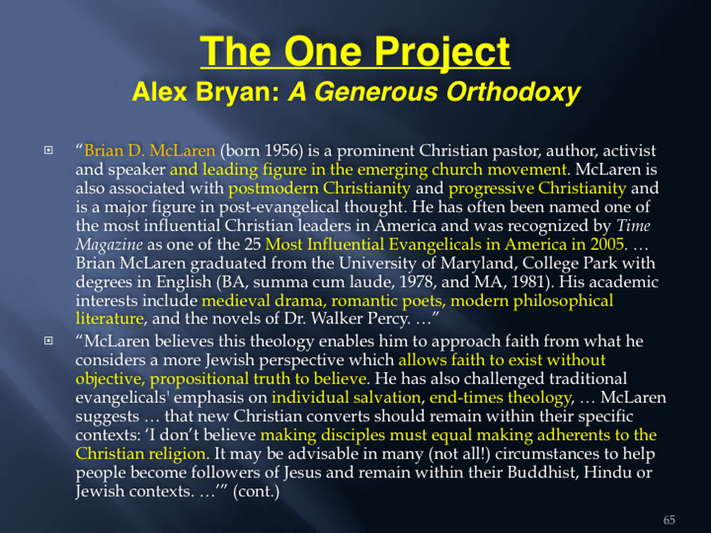
Brian McLaren, A Generous Orthodoxy (2006) The third book listed on Alex’s blog in 2007.
Biography found in Wikipedia. (http://en.wikipedia.org/wiki/Brian_McLaren)
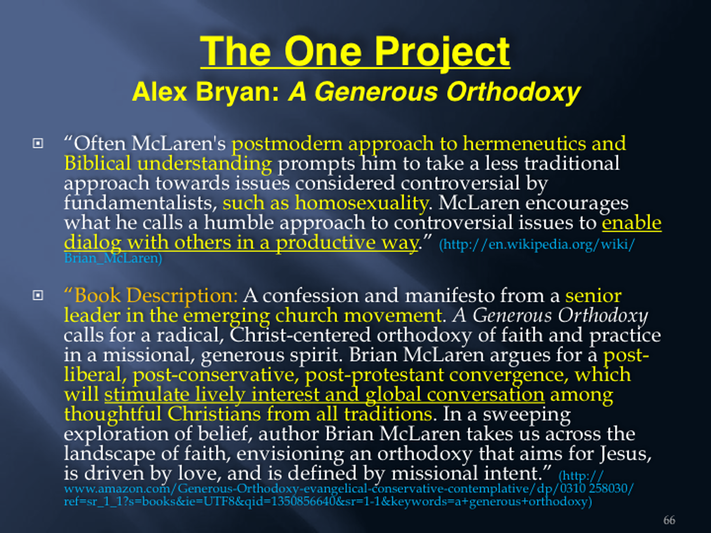
Brian McLaren, A Generous Orthodoxy (2006) The third book listed on Alex’s blog in 2007.
Wikipedia biography of McLaren continued, and Amazon.com “Book Description.” Notice again the idea of dialog and discussion and conversation.
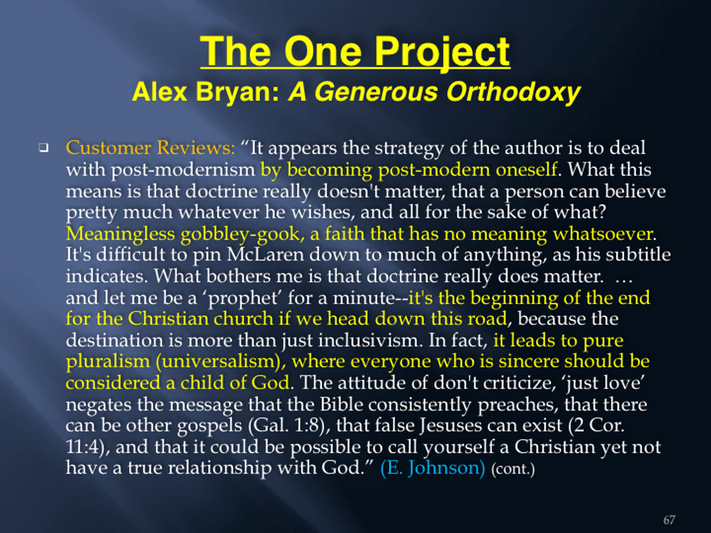
Brian McLaren, A Generous Orthodoxy (2006) The third book listed on Alex’s blog in 2007.
There are 50 One star ratings and only 58 Five star ratings on Amazon. Many Evangelical Christians responded negatively to this book. Yet Alex recommended it on his blog.
(http://www.amazon.com/Generous-Orthodoxy-evangelical-conservative-contemplative/product-reviews/0310258030/ref=cm_cr_dp_qt_hist_one?ie=UTF8&filterBy=addOneStar&showViewpoints=0)
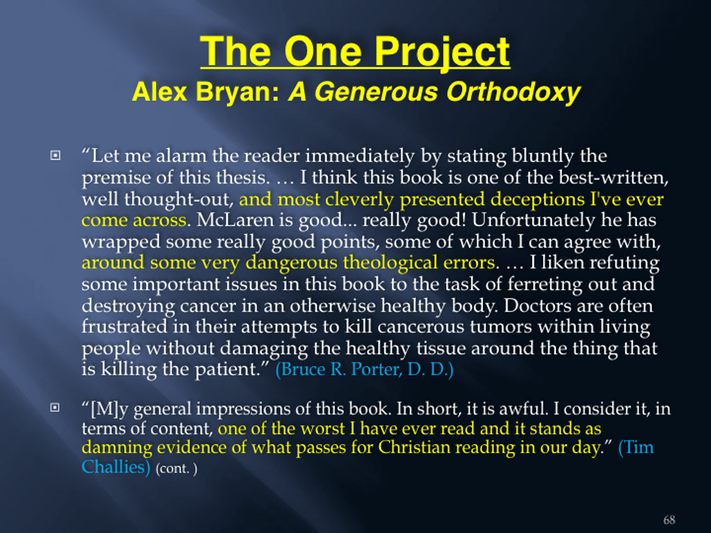
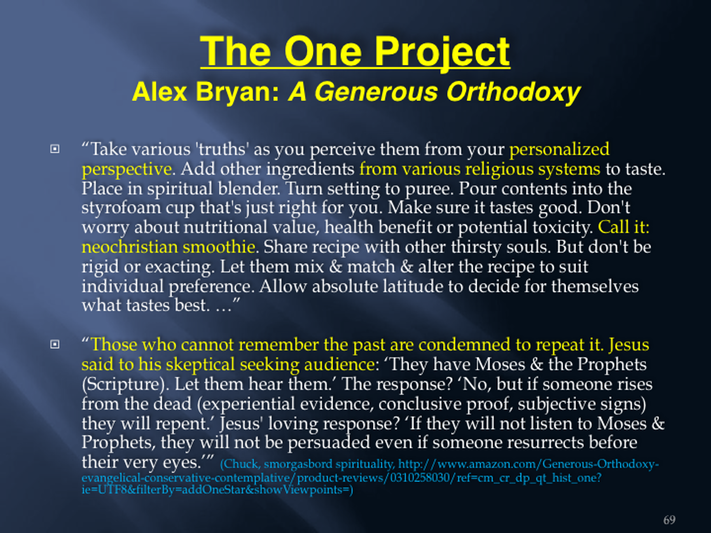
Brian McLaren, A Generous Orthodoxy (2006) The third book listed on Alex’s blog in 2007.
There are 50 One star ratings and only 58 Five star ratings on Amazon. Many Evangelical Christians responded negatively to this book. Yet Alex recommended it on his blog.
(http://www.amazon.com/Generous-Orthodoxy-evangelical-conservative-contemplative/product-reviews/0310258030/ref=cm_cr_dp_qt_hist_one?ie=UTF8&filterBy=addOneStar&showViewpoints=0)
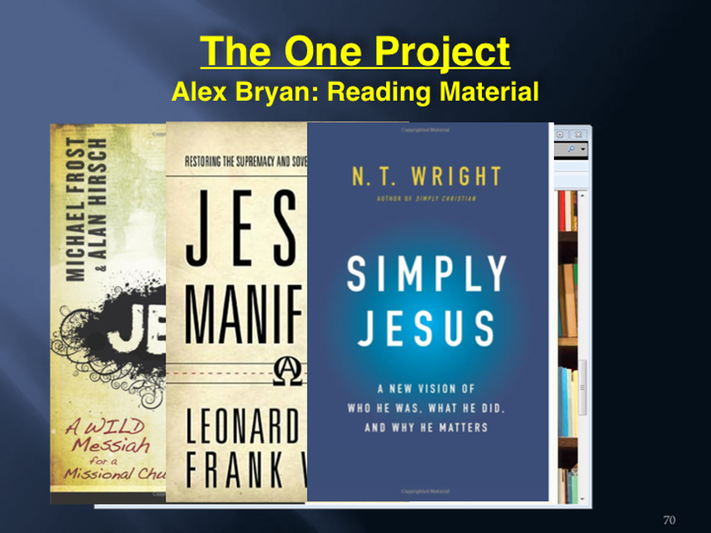
The previous list of books was on Alex’s blog in 2007. Now we will look at Alex’s blog site currently (2012 [which has since been removed from his blog]). He list several Emerging Church books among his “Some Favorite Books About Jesus” blog list. Since 2011 when controversy erupted about his recommended reading, he has added many less objectionable books to the list. But still he is promoting many Emerging Church books without any suggestion that their content is erroneous. In 2012 this list of books was removed from his blog.
Eugene Peterson Books see Above.
ReJesus, see Presentation number 5.
Jesus Manifesto, see Presentation number 3.
Simply Jesus, see below.
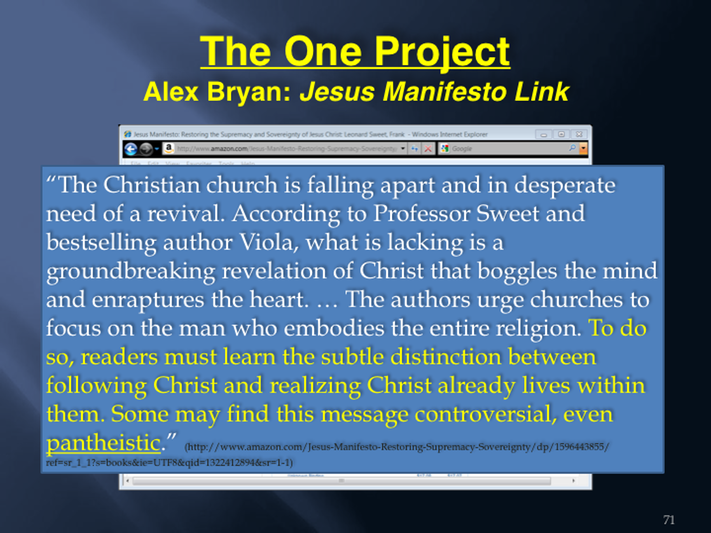
There are direct links from Alex’s blog site to Amazon.com where someone can purchase the books. Amazon lists an official Editorial Review for this book which makes it clear the book has pantheistic leanings. [This has since been removed from his blog]
(For more on this book see Presentation number 3).
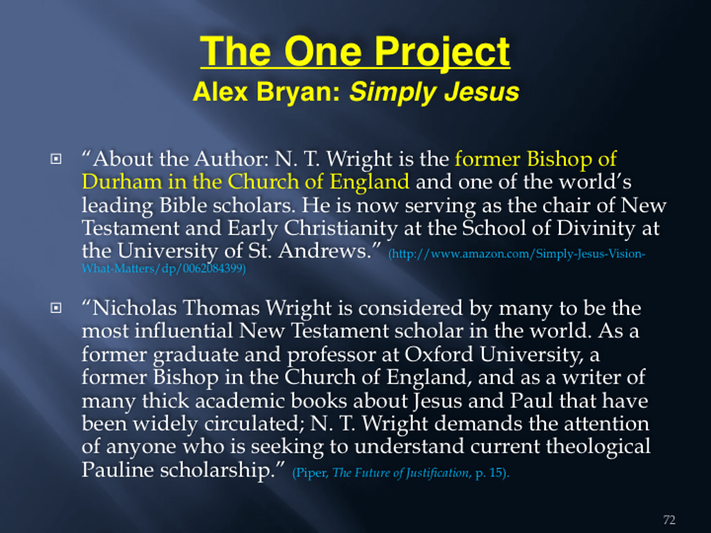
Alex’s blog recommends N. T. Wright’s book Simply Jesus. Here we look at biographical sketches of the author.
One web site we looked at offered supportive ideas about Wright and his leaning toward Catholicism:
“5 Elements of N.T. Wright’s Work that Emerging Churches often Embrace
1) The Centrality of the Church in God Saving Work: …
2) The Future Nature of Church: …
3) The Cosmic Nature of the Church: …
4) The Materiality of the Church: …
5) Improvisation in the Church: …
3 Elements of N.T. Wright’s Work that Emerging Churches often Neglect
1) Ascension of Jesus…
2) Israel: …
3) Catholicity of the Church
Qualitative – The Church transcends all social, cultural, and natural divisions. Jesus gives a new way of relating to each other. Unlike consumerism which segments people, the Church includes all kinds of people are included. The victory of Jesus over the powers of darkness is shown in an inclusive Church.
Extension – The Church is comprised of all believers in all places in all time. The united Church must have some physical presence beyond clusters of homogeneous units. There must be some kind of institution. Many in the emerging church view institutionalism as the enemy, but avoidance of institutions is often an attempt to avoid the pain of Church unity.
While there are clearly exceptions to Begbie’s generalizations about new church movements, the picture of a Church that he painted (via N.T. Wright) was both inspiring and challenging.” (http://jimvining.com/tag/n-t-wright/)
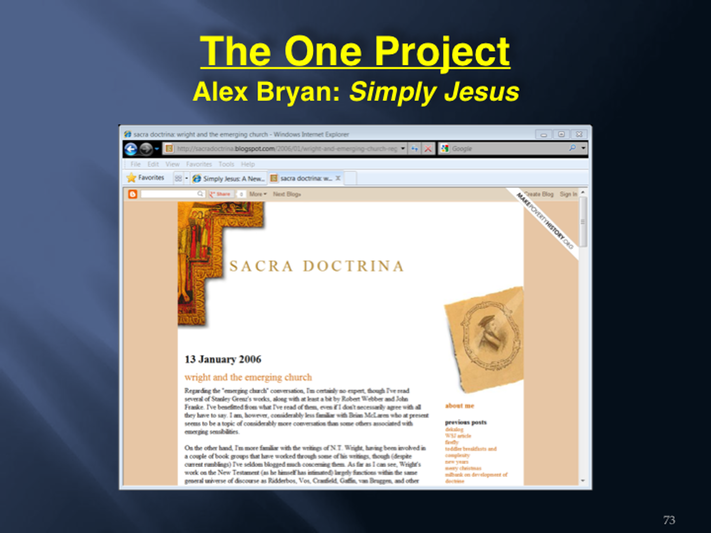
Some question Wright’s views on Scriptures and his association with the Emerging Church movement.
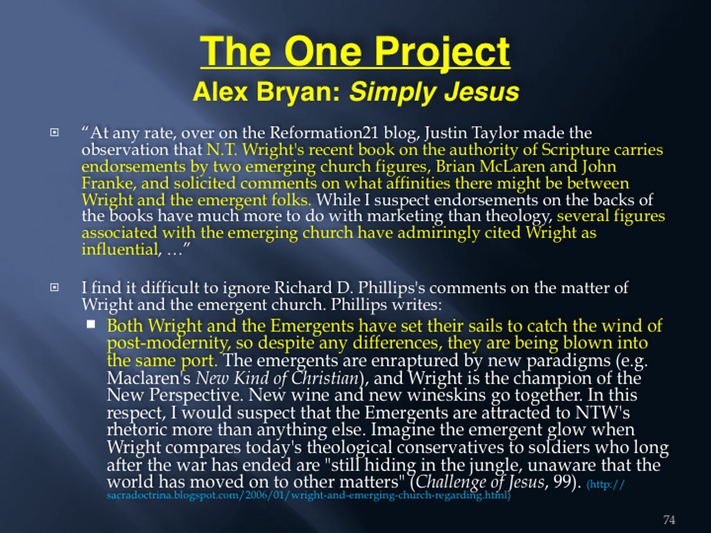
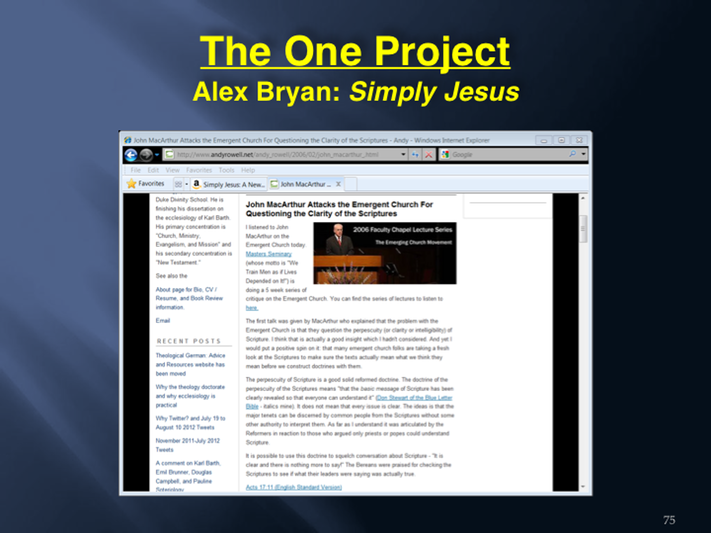
Some question Wright’s views on Scriptures and his association with the Emerging Church movement, including John MacArthur.
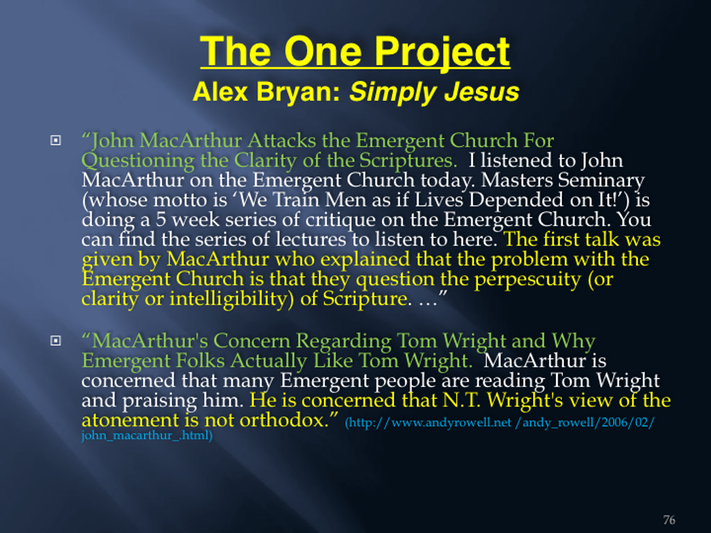
Some question Wright’s views on Scriptures and his association with the Emerging Church movement, including John MacArthur.
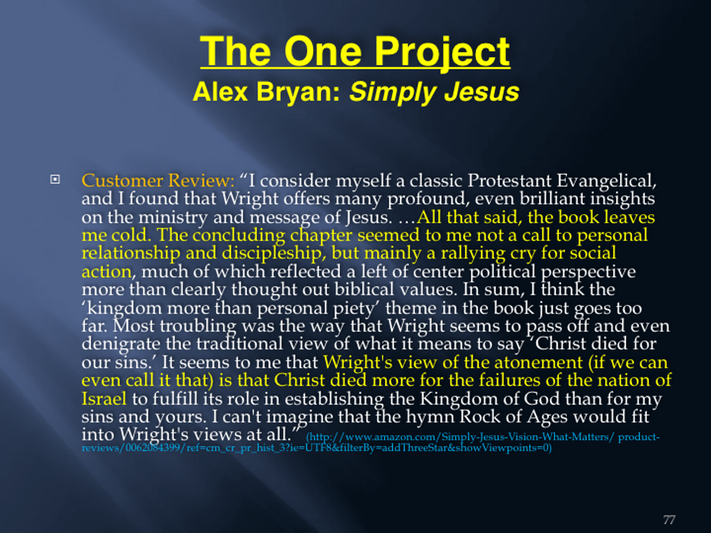
There are mixed reviews of this book even among Evangelicals yet Alex Bryan recommends the book on his blog and other One Project leaders recommend the book at their gatherings.
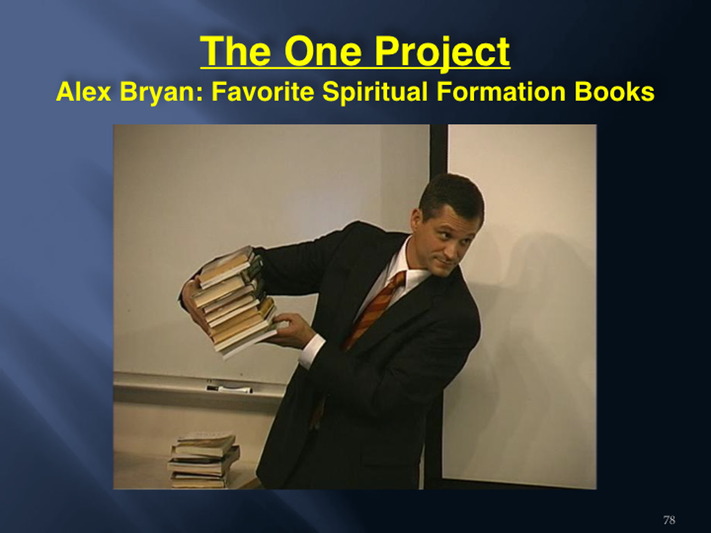
“Alex Bryan displays his favorite Spiritual Formation books at the Adventist Forum meeting held at Walla Walla University, October 2011…” (see next slide for information)

On May 24, 2014, Alex Bryan, pastor of the Walla Walla University church, made a startling presentation. ALLsanctuary windows were shuttered and taped leaving the congregation in complete darkness during a 22-minute sermon followed by an additional 2 minutes of silent darkness. His sermon advocated the necessity of darkness for us to completely communicate with God in prayer. (Even the graphics on the screen were reversed out, displaying only small white letters on a solid black background, again insuring complete darkness)
Significant quotes included excerpts from:
- Cloud of the Unknowing, by an anonymous 14th century mystic who is highly revered and advanced by the Catholic Church
- Entering the Dark Cloud of God, by Barbara Brown-Taylor, a renowned Episcopal theologian.
It is also extremely significant to note that Brown-Taylor presented an identical sermon to Bryan's May 24 sermon on May 25 at a Festival of Homiletics in Minneapolis, Minnesota. The attached link shows Time magazine's article quoting her sermon.
http://time.com/110734/sermon-series-entering-the-dark-cloud-of-god/
Along with these quotes, Bryan attempted to affirm his darkness thesis with scriptures from both the Old and New Testament, twisting texts all along the way.
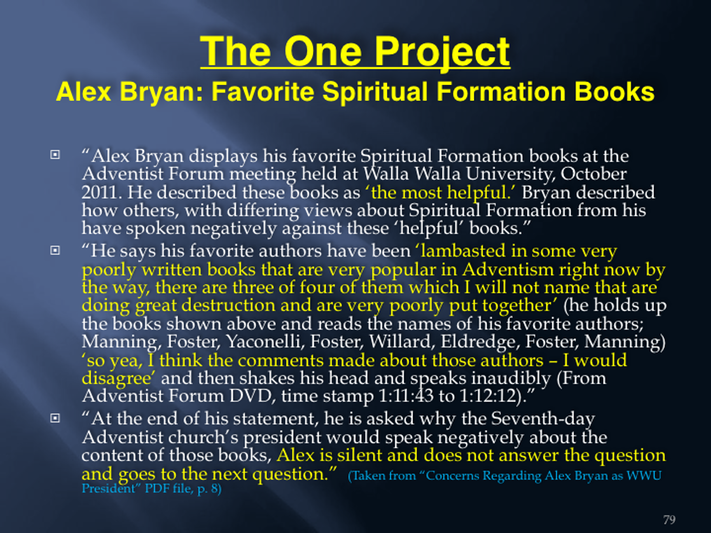
Please CLICK HERE for the second part of presentation #6